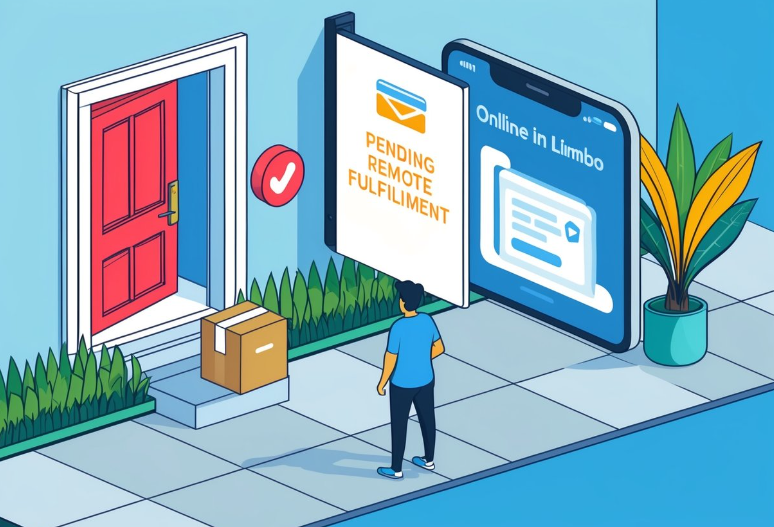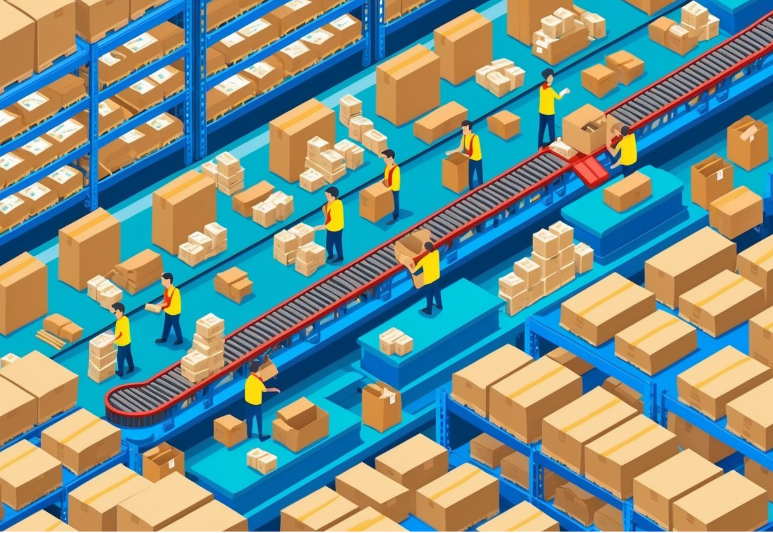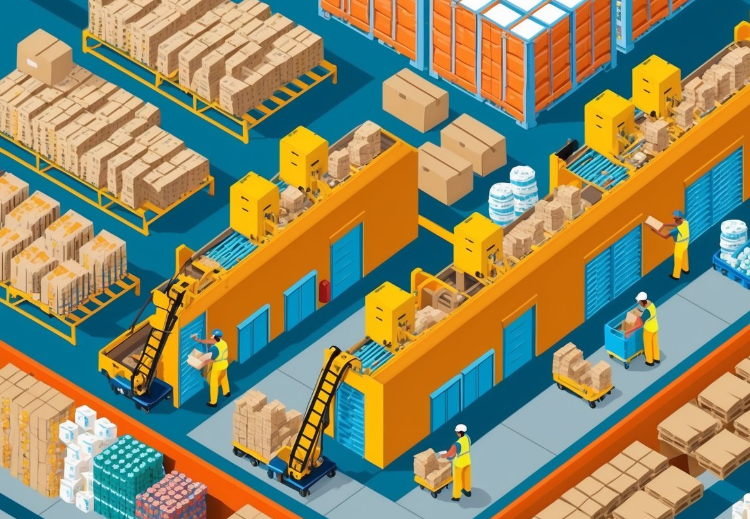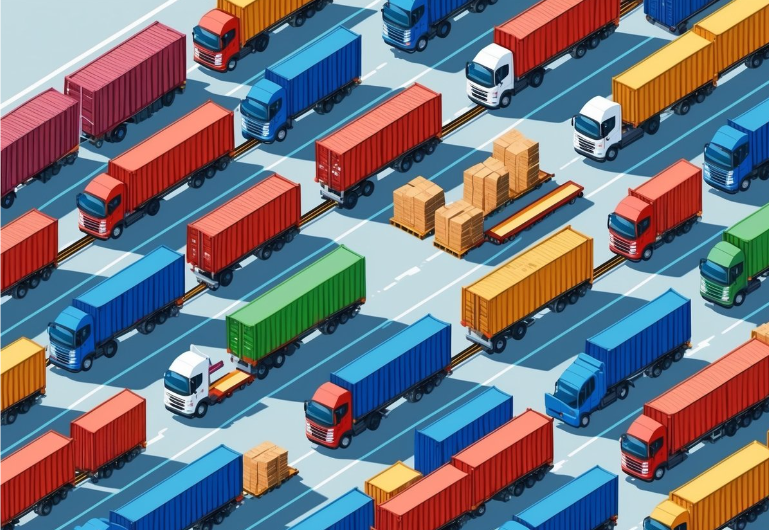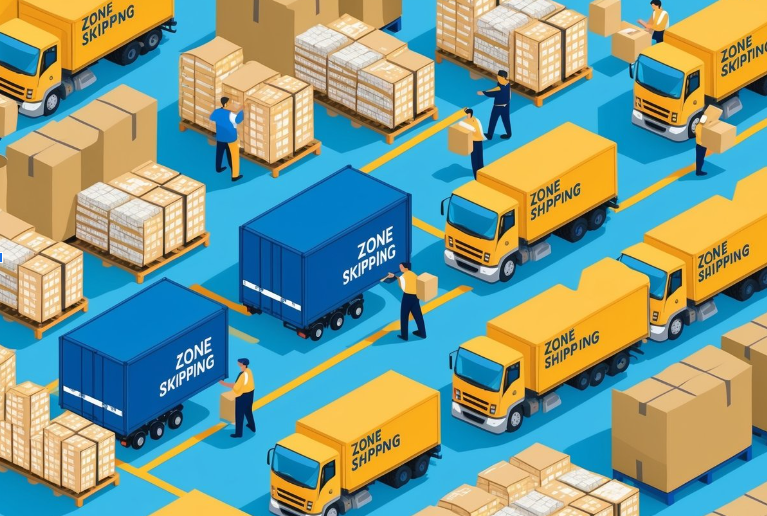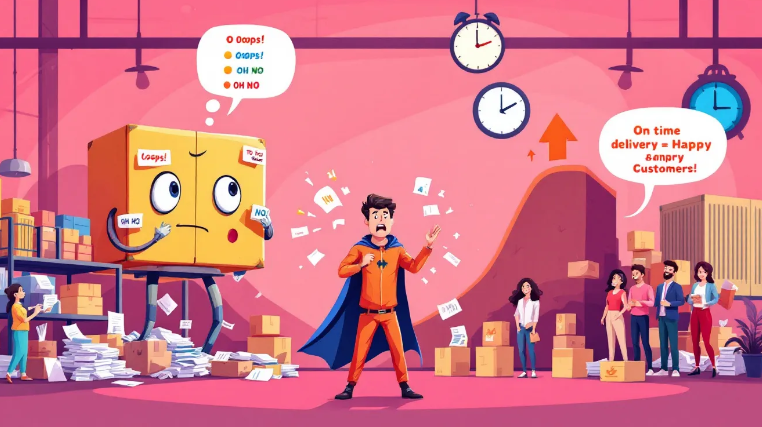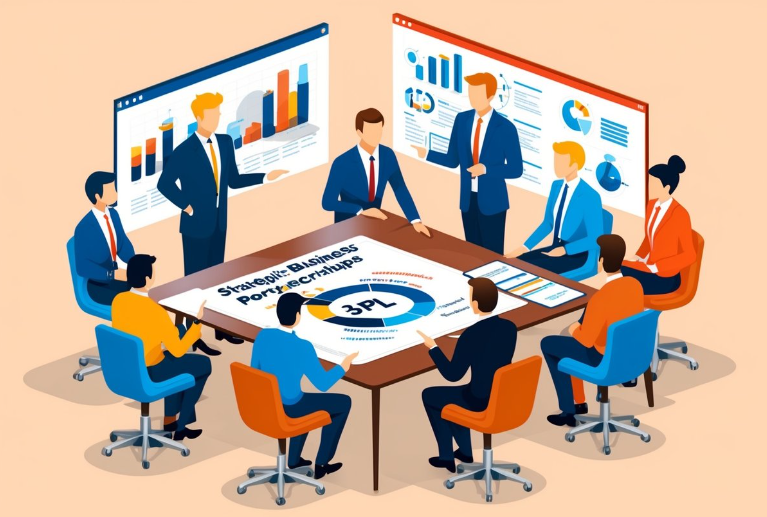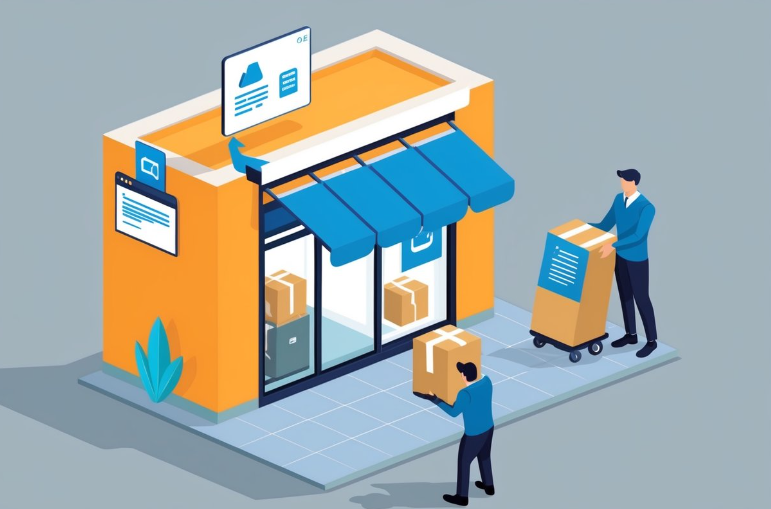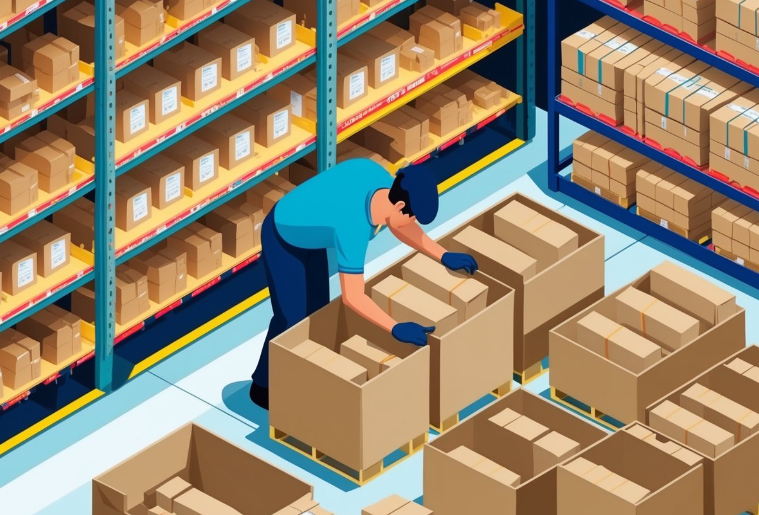What ‘Pending Remote Fulfillment’ Means for Your Online Orders: A Clear Breakdown
Pending remote fulfillment status on your order can raise questions when you’re waiting for your products to reach your customers. At IWS, we know that understanding order statuses helps you make informed decisions for your business. This guide breaks down what pending remote fulfillment means, why it happens, and how it affects your shipments.
Understanding ‘Pending Remote Fulfillment’
When your order shows “pending remote fulfillment,” it indicates your products have been received in our system and are being processed at a location different from the main fulfillment center.
What Does ‘Pending Remote Fulfillment’ Mean?
Pending remote fulfillment refers to an order status that appears after your order has been validated but before the products have been physically picked, packed, and prepared for shipping from an external fulfillment location. This happens when your products are stored at a warehouse location other than the primary facility.
For businesses shipping health and beauty products, lightweight consumer goods, or beverages, this status is a normal part of the fulfillment process. Speed and accuracy over long-term storage are which are two characteristics of fulfillment centers that distinguish them from traditional warehouses. This operational focus means your order is being coordinated through our network of strategically placed fulfillment centers to optimize shipping times and costs for your customers.
Importance of Order Status Clarity
Clear order status communication is key to maintaining your business operations and customer satisfaction. When you see “status: pending remote fulfillment” in your dashboard, this transparency allows you to:
- Provide accurate delivery estimates to your customers
- Plan your inventory replenishment accordingly
- Make informed decisions about stock levels
- Track your products throughout the fulfillment journey
For small to mid-sized brands shipping hundreds of orders monthly, having this visibility can make a significant difference in customer satisfaction rates. At IWS, we provide real-time status updates through our client portal so you always know exactly where your products are in the fulfillment process.
Why Your Order Shows ‘Pending Remote Fulfillment’

Understanding the reasons behind this status helps you better manage your business operations and customer expectations.
Strategic Inventory Distribution
When your order displays pending remote fulfillment, it’s often because we’re utilizing our network of fulfillment centers to provide you with the most cost-effective shipping solution. This strategic approach offers several benefits:
- Regional Proximity: Fulfilling orders from locations closer to your customers reduces transit times and shipping costs
- Specialized Handling: Certain products (like temperature-sensitive items) may be stored at facilities with specialized equipment
- Balanced Workload: Distributing orders across multiple facilities helps maintain processing speed during high-volume periods
For example, if your business ships beauty products to customers nationwide, we might fulfill West Coast orders from our California facility while East Coast orders are processed from our New York location, all managed seamlessly through our central system.
Seasonal Demand Management
During peak seasons like holiday shopping periods, remote fulfillment becomes an important tool to maintain service quality. When order volumes spike:
- Primary facilities may reach capacity, triggering automatic routing to secondary locations
- Special promotions can create sudden demand surges that require distributed processing
- Product-specific rushes (like seasonal beverages) might be directed to specialized handling facilities
Our systems are designed to automatically balance workloads across all facilities, maintaining consistent processing times even during your busiest seasons. This approach prevents the bottlenecks that can occur when relying on a single fulfillment location.
Influence of Third-Party Logistics (3PL)
Understanding how third-party logistics providers impact the pending remote fulfillment process helps explain why this status appears in your order tracking.
How 3PLs Manage Remote Fulfillment
As a 3PL provider, IWS creates a bridge between your business and your customers through our national network of fulfillment centers. When orders enter pending remote fulfillment status, we’re coordinating several critical aspects:
- Cross-Network Inventory Visibility: Our warehouse management system tracks your products across multiple facilities
- Order Routing Logic: Orders are assigned to facilities based on product location, destination address, and current processing capacity
- Multi-Carrier Shipping Integration: We select the optimal shipping method based on your requirements and customer location
This centralized management of distributed operations is what makes remote fulfillment possible, allowing your products to ship from the most advantageous location without requiring you to manage relationships with multiple warehouses.
Benefits of 3PL-Powered Remote Fulfillment
Working with a 3PL like IWS for your remote fulfillment needs offers distinct advantages:
- Expanded Geographic Reach: Access to fulfillment centers in multiple regions without capital investment
- Carrier Rate Negotiation: Better shipping rates through our consolidated volume across all clients
- Scalable Capacity: Ability to handle volume fluctuations without fixed overhead costs
- Technology Integration: Advanced systems that connect with your e-commerce platform and provide real-time visibility
- Specialized Expertise: 3PLs like IWS excel at small parcel fulfillment for direct-to-consumer brands, with dedicated processes that optimize packaging, reduce dimensional weight charges, and ensure prompt carrier pickups for even the smallest orders in your product catalog.
By partnering with a 3PL for remote fulfillment, you transform what could be a complex logistics challenge into a competitive advantage, letting you focus on product development and marketing while we handle the operational details of getting orders to your customers.
How Orders Move Through Remote Fulfillment
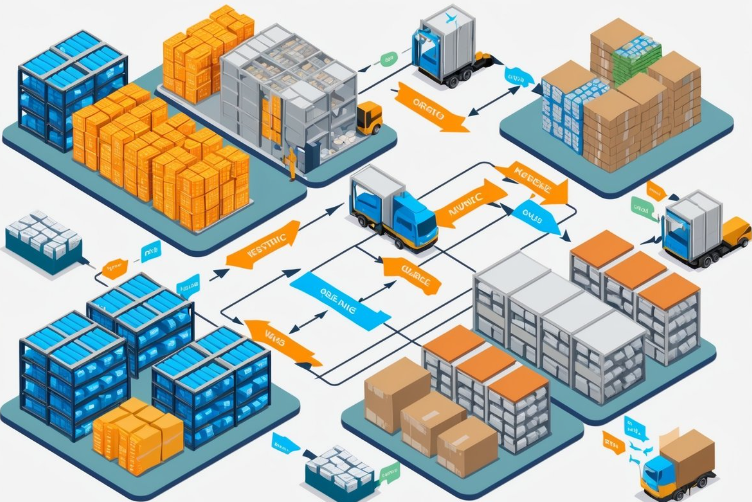
Understanding the workflow helps you track your orders and set accurate expectations for your customers.
The Order Processing Journey
When your order enters the remote fulfillment stage, it follows a structured path:
- Order Receipt: Your order is received through our integration with your e-commerce platform
- Assignment: Our system assigns the order to the optimal fulfillment location based on product availability and shipping destination
- Picking: Warehouse staff select your products from inventory locations
- Quality Check: Each item is verified against order specifications
- Packing: Products are packaged according to your requirements with any custom inserts or branded materials
- Shipping Preparation: Labels are created and carriers are assigned based on your shipping rules
- Dispatch: Products leave our facility and enter the carrier’s network
This process typically takes 1-2 business days from receipt to dispatch for standard orders. At IWS, we maintain an average accuracy rate of 99.7% through our rigorous quality control protocols.
Technology Behind Remote Fulfillment
The “pending remote fulfillment” status is made possible by our integrated technology systems that connect all aspects of the fulfillment process:
- Inventory Management System: Tracks real-time stock levels across all locations
- Order Management Platform: Intelligently routes orders to appropriate facilities
- Warehouse Management System: Guides picking, packing, and quality control processes
- Shipping Integration: Automatically selects the most cost-effective carrier options
- Client Portal: Provides you with visibility into your order status and inventory levels
This technology infrastructure allows us to maintain high service levels while giving you complete transparency into your order fulfillment operations. Through your personalized dashboard at invwhs.com, you can monitor each order’s status as it moves through the fulfillment process.
What to Expect During Remote Fulfillment
Knowing what to expect when your orders show “pending remote fulfillment” helps you manage both your operations and customer communications.
Typical Timelines
Remote fulfillment may add a small amount of processing time compared to standard fulfillment, but the overall impact on delivery is often minimal:
| Order Type | Processing Time | Notes |
| Standard Orders | 1-2 business days | Most health and beauty, lightweight consumer goods |
| Custom Packaging | 2-3 business days | Orders requiring special inserts or gift wrapping |
| Temperature-Controlled | 1-2 business days | Beverages and sensitive products |
| High-Volume Orders | 2-3 business days | Bulk shipments of 100+ identical items |
| Orders shipped NDA | Same business day | When received before 12 PM local time, ensuring delivery within 24 hours to most continental US locations |
These timelines reflect normal operations outside of peak holiday seasons, when additional processing time may be required. Our client success team will communicate any anticipated delays during high-volume periods.
Communication Best Practices
When your orders are in remote fulfillment status, following these communication practices helps maintain customer satisfaction:
- Update your shipping policy page to reflect accurate processing times
- Set automated post-purchase emails to acknowledge orders with realistic timeframes
- Use our status API to provide real-time updates on your website or app
- Train customer service staff to explain pending remote fulfillment if customers inquire
Many IWS clients find that proactive communication about order status leads to higher customer satisfaction scores and fewer support inquiries.
Optimizing Your Experience with Remote Fulfillment
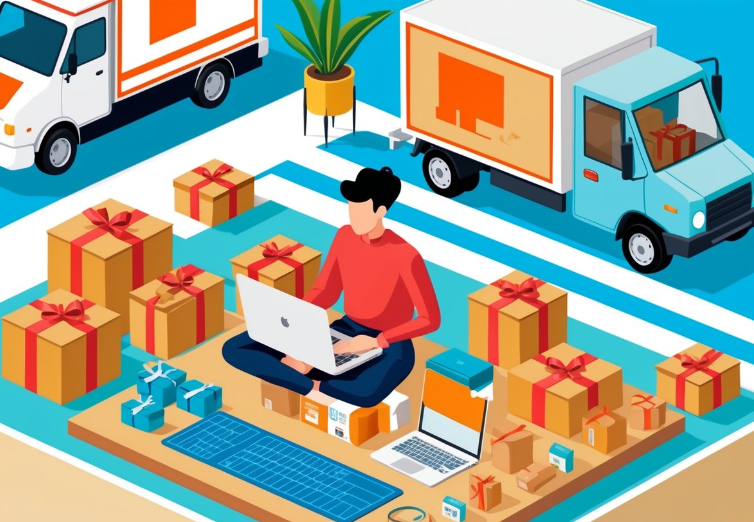
You can take several actions to make the most of remote fulfillment capabilities.
Inventory Planning Strategies
Strategic inventory management can help you maximize the benefits of remote fulfillment:
- Regional Distribution: For businesses with nationwide customer bases, distributing inventory across multiple fulfillment centers can reduce shipping times and costs
- Seasonal Preparation: Communicate expected sales spikes to your fulfillment partner in advance
- Forecast Sharing: Provide monthly projections to help us prepare adequate resources
By planning inventory levels strategically across our network, your orders can ship from optimal locations, minimizing both cost and transit time to your customers.
Working with Your Fulfillment Partner
To get the most from remote fulfillment capabilities:
- Schedule regular check-ins with your dedicated account manager
- Review fulfillment analytics through your client portal to identify patterns
- Communicate product changes or special handling requirements in advance
- Share feedback on carrier performance to help optimize shipping options
At IWS, we view ourselves as an extension of your team. Your account manager is available to answer questions about pending remote fulfillment status and help you optimize your fulfillment strategy.
Pending Remote Fulfillment FAQs
How long does pending fulfillment take?
Pending fulfillment typically takes 1 to 5 days, depending on inventory availability, order volume, and warehouse processing speed. Delays may occur due to stock shortages, high demand, or operational issues.
What causes delays in fulfillment?
Delays in fulfillment occur due to inventory shortages, supply chain disruptions, high order volume, staffing issues, or carrier delays. Poor warehouse management and inefficient order processing also slow fulfillment times.
What is the difference between fulfillment and shipping?
Fulfillment includes order processing, picking, packing, and shipping, while shipping refers only to the transportation of goods to the customer. Fulfillment is a broader process, ensuring orders are correctly prepared before shipment.
What is the difference between fulfillment and delivery?
Fulfillment involves order processing, packing, and shipping, while delivery refers to the final step of transporting the order to the customer’s location. Fulfillment ensures accurate order preparation, while delivery completes the transaction.
How can I speed up fulfillment?
Speed up fulfillment by automating order processing, optimizing warehouse layout, maintaining accurate inventory, partnering with efficient carriers, and using multiple fulfillment centers. Reducing manual tasks and improving supply chain coordination minimizes delays.
Conclusion
Understanding what “pending remote fulfillment” means gives you better control over your order fulfillment operations. This status simply indicates that your orders are being processed through our distributed network of fulfillment centers to provide optimal service to your customers.
By working closely with your fulfillment partner and maintaining clear communication with your customers, you can turn this fulfillment approach into a competitive advantage for your business. Remote fulfillment allows you to offer faster, more cost-effective shipping while maintaining the order accuracy your customers expect.
If you have questions about pending remote fulfillment or want to learn how IWS can help streamline your order processing, contact our team at invwhs.com/contact for a personalized consultation.
The Essential Guide to Distribution and Fulfillment Center Operations
Are your products reaching customers efficiently, or is your supply chain clogging up? To know the difference between direct distribution and fulfillment services, you need to understand their purposes.
Distribution centers move bulk products to retailers, fulfillment centers handle individual customer orders. This difference affects your operational costs, delivery time and customer satisfaction. For growing brands shipping 300+ orders a month, choosing the right logistics approach can mean the difference between growing and chaos.
Distribution Centers vs Fulfillment Centers
Both distribution and fulfillment centers are critical in modern supply chains but operate under different models to achieve different goals.
What is a Distribution Center?
A distribution center is designed to receive, store and redistribute large quantities of products to other businesses, retail locations or secondary distribution points. These centers connect manufacturers with retailers and wholesalers through bulk product movement.
Distribution centers process large shipments and are located in strategic places that minimize transportation costs while having access to major shipping routes. Their operations revolve around space utilization and inventory tracking systems that optimize the movement of palletized goods.
Functions of a Distribution Center
The main focus of a distribution center is the flow of products through the supply chain at scale:
- Receiving and Storage: Distribution centers receive large shipments from manufacturers, usually full truckloads or container quantities. Products are stored in palletized units not individual items.
- Cross-Docking and Redistribution: Many centers move products from inbound to outbound vehicles with minimal storage time, keeping products moving to retailers and wholesalers.
- Advanced Transfer Methods: Many distribution centers utilize the benefits of cross docking to minimize storage time and handling costs. This technique allows products to move directly from inbound to outbound transportation, dramatically reducing warehouse dwell time and accelerating the flow of goods through the supply chain.
- Transportation Optimization: Strategic locations near transportation hubs help minimize lead times while maximizing delivery efficiency, crucial for brands in competitive retail.
What is a Fulfillment Center?
A fulfillment center focuses on processing individual customer orders for direct-to-consumer businesses. While distribution centers connect businesses to businesses, fulfillment centers connect businesses to end consumers through accurate and fast order processing.
Two key characteristics of fulfillment centers are speed and accuracy over long term storage. They process high volumes of small orders, making them perfect for e-commerce businesses. Unlike distribution centers, fulfillment center operations prioritize inventory turnover over storage.
Functions of a Fulfillment Center
The specialized nature of fulfillment centers is evident in their core functions:
- Order Processing: When a customer clicks “buy” integrated systems send that information to the fulfillment center instantly and trigger the fulfillment workflow.
- Picking, Packing, and Shipping: Staff or automated systems locate products, package them for individual shipment and prepare them for delivery with emphasis on accuracy and presentation.
- Returns Management: Fulfillment centers handle return processing, inspection, restocking and refunds – a critical service for customer satisfaction.
- Specialized Handling: Modern fulfillment centers excel at small parcel fulfillment for direct-to-consumer brands, with expertise in packaging individual items safely and cost-effectively regardless of size or fragility. This specialization is particularly valuable for businesses with diverse product catalogs or those selling items requiring special handling.
Distribution and Fulfillment Services Comparison

Understanding the operational differences between these two logistics models helps businesses make informed decisions about their supply chain.
Direct Distribution vs Fulfillment Services
Direct distribution and fulfillment services are two different ways to get products to their destination. The key differences lie in the level of control, operational involvement and target recipients.
In direct distribution businesses have more control over the entire process from warehouse operations to transportation logistics. This is typically company owned or contracted facilities moving products to retail locations or other businesses. The focus is on bulk movement and inventory positioning.
Fulfillment services on the other hand specialize in individual customer orders, often as a third-party provider. These services excel in processing many small orders not few large shipments. For e-commerce businesses partnering with a fulfillment service like Innovative Warehouse Solutions allows them to focus on product development and marketing while leaving the operational logistics to experts.
Operational and Logistical Differences
The operational structures of these two models reveal significant contrasts in how they function:
| Aspect | Direct Distribution | Fulfillment Services |
| Control | Complete control over logistics operations including staffing, equipment, and transportation | Operations managed by third-party experts with limited direct oversight |
| Flexibility | More standardized operations year-round with less ability to scale quickly | Easily scales during peak seasons without requiring additional infrastructure investment |
| Technology Focus | Emphasis on inventory tracking and route optimization for bulk shipments | Priority on order management systems integrated with e-commerce platforms and real-time consumer updates |
| Order Types | Primarily handles large, bulk shipments to businesses | Specializes in processing numerous small individual orders |
| Geographic Reach | Limited by company-owned facility locations | Access to established network of fulfillment centers for broader coverage |
Advantages and Disadvantages
Each approach offers distinct benefits and challenges that businesses should consider when developing their logistics strategy.
| Direct Distribution | Fulfillment Services | |
| Advantages | Direct distribution provides greater control over brand presentation and customer experience. Companies can potentially achieve higher margins by eliminating third-party costs. This model also offers direct access to distribution data and insights, along with the ability to customize operations for specific product requirements. | Fulfillment services require reduced capital expenditure through transparent, pay-for-what-you-use pricing models. Businesses gain access to established logistics networks and expertise without building their own. This approach offers the ability to scale operations quickly during growth periods, while allowing companies to focus resources on creating products and generating sales rather than managing logistics. |
| Disadvantages | This approach requires significant capital investment in facilities, equipment, and personnel. It involves complex logistics management requiring specialized expertise that may distract from core business growth. Direct distribution offers less flexibility during seasonal fluctuations and creates geographic limitations based on facility locations. | Fulfillment services provide less direct control over fulfillment operations, which may create consistency challenges. Some providers lack transparency in their pricing and performance metrics. Companies may face challenges with accommodating complex product requirements unless they choose a partner experienced in their specific industry. |
Future of Distribution and Fulfillment
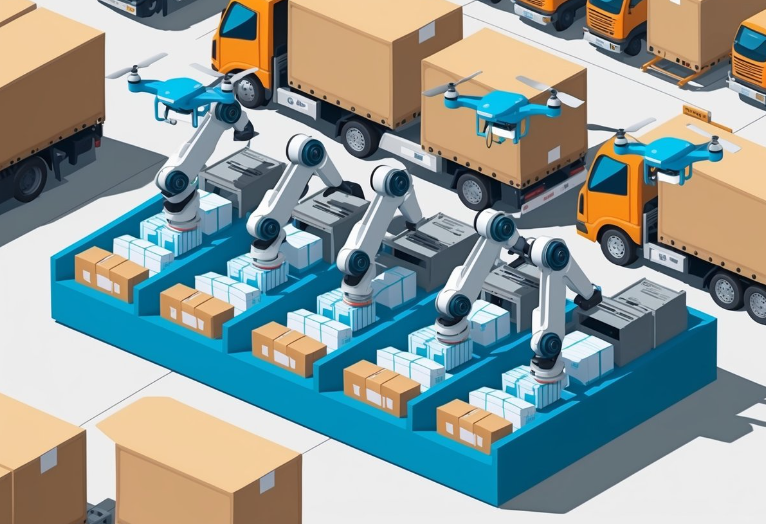
The landscape is changing driven by technological innovation and consumer expectations. Understanding the trends helps businesses prepare for what’s next.
Technology
Technology is impacting both distribution and fulfillment:
- Automation and Robotics: Warehouse automation is changing picking, packing and sorting processes. Mobile robots and automated storage systems increase efficiency and reduce labor costs, allowing industry leaders to maintain accuracy even during peak volume.
- Artificial Intelligence and Predictive Analytics: Smart systems optimize inventory levels, anticipate demand fluctuations and identify potential supply chain disruptions before they happen. This proactive approach keeps inventory balanced and prevents stockouts.
- Integration: Modern fulfillment centers offer seamless integration with e-commerce platforms like Shopify, WooCommerce and Amazon. These connections eliminate manual order processing and provide real-time inventory visibility across all sales channels.
- Last Mile: New approaches to final delivery include micro-fulfillment centers in urban areas and strategic regional placement to reduce shipping costs and delivery times. These solutions address the most expensive part of the delivery process.
- Order Status Transparency: Modern fulfillment systems provide customers with detailed tracking information throughout the delivery process. Understanding terms like pending remote fulfillment helps both businesses and consumers track order status accurately and predict delivery timeframes, leading to improved customer communication and satisfaction.
Sustainability
Environmental concerns are reshaping logistics across both distribution and fulfillment:
- Green Facility Design: Modern logistics facilities are incorporating sustainable features like energy efficient systems and water conservation measures. These reduce environmental impact and often lower operational costs.2. Packaging: Sustainable packaging reduces waste and protects products during transit. Right-sized packaging, biodegradable materials and reusable containers make for more eco-friendly fulfillment.
- Transportation: Route optimization, vehicle efficiency and load consolidation reduce carbon emissions in product movement. Good for the planet and the bottom line.
- Circular Supply Chains: Advanced returns processing creates circular supply chains where products and materials stay in circulation through multiple lifecycles. This requires sophisticated tracking and processing.
Direct Distribution and Fulfillment Services FAQs
What is the difference between direct distribution and indirect distribution?
The main difference between direct and indirect distribution is intermediaries. Direct distribution sells products straight to consumers without third parties, while indirect distribution uses wholesalers, retailers, or distributors to reach customers. Direct distribution offers more control and higher profits, but indirect distribution provides wider market reach.
What is the difference between fulfillment and logistics?
Fulfillment focuses on processing and delivering customer orders, including storage, packing, and shipping. Logistics involves broader supply chain management, covering transportation, warehousing, and inventory control. Fulfillment is a part of logistics, ensuring efficient order handling and customer satisfaction.
What is the difference between a fulfillment center and a warehouse?
A fulfillment center processes and ships customer orders quickly, handling inventory storage, picking, packing, and shipping. A warehouse primarily stores goods for long periods without actively handling order processing. Fulfillment centers focus on speed and efficiency, while warehouses prioritize bulk storage.
What is the difference between fulfillment service and dropshipping?
A fulfillment service stores, packs, and ships products for businesses that own inventory. Dropshipping allows retailers to sell products without holding inventory, with suppliers shipping orders directly to customers. Fulfillment services require inventory investment, while dropshipping eliminates upfront stock costs.
What is the difference between direct to consumer and dropshipping?
Direct-to-consumer (DTC) brands sell products directly to customers, managing inventory and fulfillment. Dropshipping relies on third-party suppliers to handle inventory and shipping. DTC offers better brand control and higher margins, while dropshipping minimizes risk but reduces control over product quality and delivery.
Conclusion
The decision between direct distribution and fulfillment services is a strategic one with big implications for your business growth. Distribution centers are great at moving bulk quantities to businesses, fulfillment centers are expert at processing individual orders for end consumers.
For most businesses shipping 300+ orders a month, the best approach depends on your specific needs, resources and growth stage. Many successful companies use hybrid models, direct distribution for certain channels and fulfillment services for e-commerce.
As technology evolves and consumer expectations change, both distribution and fulfillment must adapt. The winning logistics strategies will be automated, transparent and customer centric.
Ready to transform your logistics? Contact Innovative Warehouse Solutions today to talk about how our transparent, customer focused fulfillment services can help your business grow and simplify operations.
How Cross Docking Can Enhance Your Supply Chain Performance
Is your supply chain slowing down your business growth? Cross-docking benefits could be the answer you’re looking for.
This logistics strategy eliminates storage by moving products directly from incoming to outgoing vehicles and cuts handling time and costs. While traditional warehousing ties up your capital in inventory, cross-docking keeps products moving through your supply chain, helps you deliver faster to customers, and has leaner operations.
What is Cross Docking
Let’s break down what cross docking is and how it differs from traditional warehousing methods so you can understand its impact on your supply chain.
What is Cross Docking?
Cross docking is a logistics practice where products from a supplier or manufacturing plant are delivered directly to a customer or retail chain with minimal to no handling or storage time. Instead of storing products in a warehouse, products are unloaded from incoming trucks and loaded onto outgoing trucks, often within 24 hours.
Unlike traditional warehousing, which focuses on storage, cross docking creates a smooth flow of products across the supply chain. In a traditional warehouse, goods sit in storage for days, weeks, or even months before shipping to their final destination. With cross docking, products sit in the distribution center just long enough to be sorted and organized for outbound transportation.
Main Benefits of Cross Docking
One of the biggest benefits of cross-docking is cost reduction. By minimizing or eliminating storage requirements, businesses can reduce warehouse space needs, cutting costs associated with facility maintenance, utilities, and storage equipment. This turns fixed costs into variable costs that scale with your business.
Cross docking also speeds up delivery times. With products in transit and handling for less time, goods get from manufacturer to customer much faster. This is especially valuable for perishable or time-sensitive products that need to get to customers quickly to maintain quality or meet market demands.
Cross Docking vs Traditional Warehousing
Traditional warehousing follows a receive-store-pick-pack-ship model where goods are stored for varying periods. Cross docking follows a streamlined receive-sort-ship process within a shorter timeframe. This difference impacts everything from facility design to staffing and technology needs.
For supply chain managers looking to identify differences between direct distribution and fulfillment services, understanding these operational distinctions is crucial for determining which model best suits specific product categories and business requirements.
Cross docking is ideal for high-volume, fast-moving products with predictable demand. For example, retail chains use cross-docking for core products that sell consistently. Traditional warehousing is better suited for products with unpredictable demand patterns, seasonal products, or products that require special handling or storage conditions.
Cross Docking’s Impact on Supply Chain Performance

Implementing cross-docking can change your supply chain operations in many ways. Here’s how this strategy can improve efficiency and reduce costs across your logistics network.
Speed and Efficiency
Cross docking simplifies the flow of goods by removing unnecessary steps between suppliers and customers. Products move through the supply chain without the delays associated with storage, picking, and packing. This direct transfer approach can reduce handling time by up to 60% compared to traditional warehousing methods.
The reduction in touchpoints has ripple effects throughout the supply chain. Every time a product is handled, there’s a chance of damage, misplacement, or administrative errors. By minimizing these interactions, cross docking not only speeds up delivery but improves accuracy and reduces product damage rates.
Many major retailers have seen significant performance improvements after implementing cross-docking. For example, some retail chains have reported 15-20% faster delivery times and a 25% increase in inventory turns after moving selected product lines to cross-docking operations.
Cost Savings
The cost benefits of cross-docking go beyond simple warehousing cost reduction. By eliminating storage, businesses can operate with smaller facilities focused on sorting and transfer rather than large warehousing. This can reduce facility costs by 25-30% compared to traditional warehousing operations. When combined with techniques like what is zone skipping, businesses can further optimize their logistics network to minimize transit zones and significantly reduce shipping expenses across regional boundaries.
Labor costs are also reduced through cross-docking. With fewer picking, packing, and inventory management tasks, staffing needs decrease while productivity per employee increases. Transportation costs can be optimized through better consolidation and route planning, especially when cross-docking facilities are located to serve multiple markets.
A medium-sized consumer goods company working with specialized logistics partners like Innovative Warehouse Solutions reported annual savings of $250,000 after implementing cross docking for their fast-moving product lines. These savings were mainly from reduced warehousing costs, lower inventory carrying costs, and better transportation utilization.
Customer Satisfaction
In today’s market, customer expectations for fast delivery continue to rise. Cross docking helps businesses meet these demands by reducingthe time products spend in the supply chain. When done correctly cross docking can cut delivery times by 1-3 days compared to traditional warehousing methods, giving you a significant competitive advantage.
The ability to respond quickly to market demand is another customer satisfaction driver. Cross docking facilities can process large volumes of products quickly, allowing businesses to respond faster to sudden demand spikes or distribute new product launches. This responsiveness builds customer trust and loyalty.
Companies that have implemented cross-docking have seen measurable improvements in customer satisfaction metrics. According to data from retailers that have cross-dock buildings, on-time delivery rates improved by 12% and order accuracy by 8% after implementing cross-docking for suitable product lines.
Implementing Cross-Docking in Your Supply Chain

Successful cross-docking integration into your logistics operations requires planning and the right resources. Let’s look at what you need to make cross-docking work for your business.
Infrastructure and Technology
Effective cross-docking needs a specific facility design. The ideal cross-dock building has a rectangular, or I shape with multiple dock doors on opposite sides—inbound shipments come in one side, and outbound shipments go out the other. The facility should have minimal interior obstructions to allow for efficient product movement and sorting.
Technology plays a big part in managing cross-docking operations. A WMS that supports cross-docking functionality is essential for coordinating the movement of goods. This system needs to provide real-time visibility into incoming and outgoing shipments, automate sorting decisions, and assign dock doors.
Modern cross-docking operations are incorporating technologies like barcode scanning, RFID tracking, and automated sorting systems to reduce handling time and improve accuracy. Some advanced systems even use predictive analytics to predict incoming shipment volumes and adjust staffing and resource allocation accordingly.
Strategic Planning and Execution
Implementing cross-docking starts with identifying which products are best suited for this approach. Ideal candidates are high-volume items with predictable demand, products with short shelf life, and pre-packaged items that require minimal handling. Start with a limited product selection to test processes before rolling out to other suitable items.
Cross docking needs to align with your overall supply chain strategy. This includes working with suppliers to ensure product quality and delivery schedules. Many companies have strict vendor compliance programs that specify packaging requirements, labeling standards, and delivery windows to support cross-docking operations.
When evaluating cross-docking rates and adoption timing, consider starting with a pilot program on a single product category or specific high-volume customers. This allows you to refine processes, train staff, and identify potential issues before full-scale implementation.
Partnering with 3PLs for Cross Docking
For many businesses, partnering with a 3PL is the fastest way to implement cross-docking. 3PLs already have the infrastructure, technology, and operational expertise to do cross-docking. This partnership approach eliminates the need for capital investment in facilities and systems.
3PLs that specialize in cross-docking can provide the flexibility and scalability that’s hard to achieve on your own. During peak seasons or promotional periods you can increase your cross docking volume without capacity constraints. During slower periods, you can scale back without maintaining unused infrastructure.
When selecting a 3PL partner for cross docking services, evaluate their experience with similar products and industries. Ask for specific information on their cross dock vs rear load facilities, as the facility design makes a big difference to operational efficiency. Many businesses find that partners who excel at small parcel fulfillment can offer more comprehensive solutions that integrate cross docking with last-mile delivery needs. Other key factors are geographic coverage, technology capabilities and established carrier relationships.
Cross Docking Advantages FAQs
What are the three main types of cross-docking?
The three main types of cross-docking are manufacturing cross-docking, retail cross-docking, and opportunistic cross-docking. Manufacturing cross-docking consolidates raw materials for production. Retail cross-docking moves products directly to stores. Opportunistic cross-docking transfers incoming shipments to outbound trucks without storage.
What is the difference between cross-docking and transloading?
The main difference between cross-docking and transloading is storage and handling. Cross-docking transfers goods directly from inbound to outbound transport with minimal storage time. Transloading involves temporary storage and transferring goods between different transportation modes, such as from rail to truck.
What type of product is most suitable for cross-docking?
Perishable goods, high-demand retail items, and pre-packaged consumer products are most suitable for cross-docking. These items require fast movement through the supply chain to prevent spoilage, meet demand, or reduce storage costs.
What are the risks of cross-docking?
The risks of cross-docking include inventory mismanagement, delays, damaged goods, and high dependency on logistics coordination. Without precise timing and tracking, errors can disrupt operations and increase costs.
What are the challenges of cross-docking?
The main challenges of cross-docking include supply chain synchronization, infrastructure investment, and reliable supplier coordination. Efficient cross-docking requires real-time inventory tracking, skilled labor, and advanced warehouse management systems to prevent bottlenecks.
Conclusion
Cross docking benefits continue to make this logistics strategy attractive for businesses looking to optimise their supply chain. By removing unnecessary storage and handling you can achieve significant cost savings and speed to market and customer satisfaction. The cross docking vs traditional warehousing comparison clearly shows that for the right products and market conditions cross docking is the better option.
As supply chains get more complex and customer demand for fast delivery continues to rise cross docking is a practical solution that answers both operational and market demands. Whether implemented in-house or with a 3PL partner cross docking can turn your logistics into a competitive advantage.
Ready to Try Cross Docking for Your Business?
At Innovative Warehouse Solutions, we specialize in helping businesses implement effective cross docking strategies that deliver measurable supply chain improvement. Our transparent pricing means you’ll always know what you’re paying for, no hidden fees or surprises.
Ready to find out more about cross docking for your business? Contact us today for a consultation. Our logistics experts will help you determine if cross docking is right for your products and develop a customised implementation plan that fits your business goals.
Cargo vs Shipment: Key Differences & Practical Examples Explained
Confused about the difference between cargo and shipment in your logistics operations? This isn’t just a matter of semantics—it affects how you communicate with partners, plan your supply chain, and manage your documentation.
Both terms relate to goods being moved but serve different purposes in the logistics world. Understanding the shipment vs cargo distinction helps you speak the language of logistics professionals and make better decisions about your business’s transport needs.
Understanding Cargo vs Shipment
From documentation to planning, knowing when to use “cargo” versus “shipment” impacts your whole logistics operation.
Definitions
Cargo refers to the physical goods or merchandise being transported, typically in bulk. It’s the actual items, products, or materials being moved from one location to another. Cargo is about the physical items themselves, regardless of how they’re packaged for transport. When logistics professionals talk about cargo, they’re talking about the actual physical goods—whether raw materials, finished products, or components.
Shipment describes the process of moving goods or the organized unit of goods being sent from one place to another. A shipment includes not just the cargo itself but also the documentation, packaging, and transportation method. When you track a shipment, you’re following the journey of a specific consignment that has been organized for delivery.
Key Differences
The table below highlights the essential distinctions between cargo and shipment:
| Aspect | Cargo | Shipment |
| Definition | The physical goods or merchandise being transported | The process of transporting goods or the organized unit being sent |
| Focus | The actual items themselves | The journey and logistics of moving items |
| Usage Example | “The cargo was damaged during handling” | “The shipment was delayed due to weather” |
| Documentation | Described in packing lists and manifests | Tracked with waybills, BOLs, and tracking numbers |
| Insurance | Cargo insurance covers the goods themselves | Shipment insurance may cover the entire process |
| Responsibility | Typically, the concern of warehousing staff | Managed by logistics and transportation teams |
These distinctions matter significantly when communicating with logistics partners, filing insurance claims, or preparing customs documentation.
Why It Matters
Using the right terminology ensures clear communication with logistics partners, carriers, and customs officials. Confusion about whether you’re talking about the physical goods (cargo) or the transport unit and process (shipment) can lead to errors in documentation, insurance gaps, or compliance issues.
For businesses using fulfillment services, this affects how you communicate your needs and understand the services provided. When a logistics provider talks about handling your cargo, they’re referring to the physical management of your goods. When they mention processing your shipments, they’re talking about moving your goods from origin to destination.
Modes of Transport for Cargo

Each transport mode has its own advantages that can impact your supply chain efficiency and costs.
Cargo Ships
Maritime transport is the backbone of global trade, moving around 90% of the world’s cargo by volume. Cargo ships are the most efficient for bulk and non-time-sensitive goods. These vessels, especially container ships, can move massive amounts of cargo across oceans at relatively low cost per unit.
The efficiency of maritime cargo transport comes from economies of scale—a single large container ship can carry over 20,000 TEU (twenty-foot equivalent units). This capacity makes sea transport the most cost-effective option for international trade, especially for heavy or bulky items where air freight would be too expensive.
Cargo Planes
When speed is more important than cost, air cargo is the fastest option. Air transport is ideal for high-value, time-sensitive, or perishable cargo that justifies the premium cost. Electronics, pharmaceuticals, fashion items, and emergency supplies often travel as air cargo.
For businesses with urgent delivery needs, specialized NDA shipping services provide guaranteed next-day delivery, further reducing transit times for critical items while maintaining careful handling standards throughout the logistics process.
While more expensive than sea transport, air cargo has its advantages: dramatically reduced transit times, higher security, and access to regions without seaports. For businesses where time-to-market is critical, the speed of air cargo can offset its higher cost through reduced inventory holding and faster cash conversion cycles.
Freight Trucks and Trains
Land-based cargo transport through trucks and trains is the middle mile in most supply chains. Trucks offer flexibility and direct point-to-point delivery, while trains excel at moving large cargo volumes over long distances.
Intermodal transport—combining multiple modes such as truck to rail or truck to ship—optimizes the whole cargo journey. This allows businesses to leverage the strengths of each transport mode, creating more resilient and cost-effective supply chains. For example, cargo might travel by sea across oceans, then transfer to trains for long-distance land transport and finally complete the final delivery by truck.
Types of Shipments
Understanding different shipment types helps you choose the most cost effective and efficient option for your business.
Full-Truckload or Full-Container Load (FTL/FCL)
FTL/FCL shipments involve booking an entire truck or container for your goods. This is ideal when shipping volumes that can fill or nearly fill a container or truck. The main benefits include reduced handling of goods, lower risk of damage and usually faster transit times as the vehicle goes directly to the destination without multiple stops.
From a cost perspective, FTL/FCL shipments often have better per-unit shipping rates when shipping large volumes. Additionally, these shipments minimize the risk of cross-contamination or mixing with other shippers’ goods. For businesses with consistent high-volume shipping needs, setting up regular FTL/FCL shipments means predictable logistics costs and timelines.
Less-than-Truckload or Less-than-Container Load (LTL/LCL)
LTL/LCL shipments allow businesses to move smaller quantities of goods without paying for unused space. With this approach, multiple shippers share the cost of a single container or truck, each paying only for the space their cargo occupies. This makes sense for businesses with smaller shipping volumes or irregular shipping schedules.
While LTL/LCL shipments are usually more expensive per cubic foot than full loads, they eliminate the need to wait until you have enough goods to fill an entire container. For small to mid-sized businesses, this means you can ship products as needed rather than based on container capacity. This approach works particularly well when combined with effective small parcel fulfillment strategies for your direct-to-consumer orders.
Innovative Warehouse Solutions specializes in optimizing LTL/LCL shipments for growing businesses, helping them balance cost efficiency with delivery time.
Choosing the Right Logistics Partner

The difference between logistical headaches and smooth operations often comes down to choosing the right partner for your cargo and shipment needs.
Importance of a Reliable Partner
A strategic logistics partner does more than just move cargo from A to B—they become an extension of your business. The right partner has expertise in navigating complex shipping regulations, optimizing transport routes, and managing documentation properly. This expertise directly impacts your bottom line through reduced shipping costs, fewer delays, and higher customer satisfaction.
When evaluating potential logistics partners, look beyond basic pricing to assess their on-time delivery record, communication transparency, technology capabilities, and problem-solving skills. The most valuable logistics relationships are built on consistent performance and proactive communication, especially when things go wrong.
Modern businesses often sell through multiple channels simultaneously—from e-commerce websites to marketplaces and physical retail locations. In these cases, partnering with providers offering omnichannel 3PL services becomes essential for maintaining consistent inventory records and fulfillment standards across all sales channels. This integrated approach ensures that cargo handling and shipment processes remain synchronized regardless of where customer orders originate.
Innovative Warehouse Solutions Advantage
Innovative Warehouse Solutions offers a customer-centric approach that sets us apart in the 3PL industry for businesses looking to optimize their cargo management and shipment processes. Unlike big impersonal logistics providers, IWS focuses on creating tailored solutions for small to mid-sized businesses shipping at least 300 orders a month.
The IWS advantage is in combining technology with customer service. Their warehouse management system has real-time visibility into inventory and shipments and their transparent pricing model eliminates the hidden fees common in logistics services. This technology and transparency allow businesses to make data-driven decisions and have predictable operational costs.
Shipment vs Cargo FAQs
What is the difference between cargo and freight shipping?
Cargo refers to goods transported via air, sea, or land, typically in bulk. Freight shipping specifically refers to commercial transportation of goods, usually by trucks, trains, ships, or planes. Cargo is a broader term, while freight shipping is a method of transporting cargo.
What is the difference between shipment and transportation?
Shipment refers to a specific set of goods being transported, while transportation is the overall process of moving goods from one place to another. Shipment is a unit of transported goods, whereas transportation includes vehicles, routes, and logistics.
What are the three types of cargo?
The three main types of cargo are general cargo, bulk cargo, and liquid cargo. General cargo includes packaged goods like electronics. Bulk cargo consists of unpackaged goods like coal or grain. Liquid cargo includes fluids like oil or chemicals.
What is cargo in shipping terms?
In shipping, cargo refers to goods or merchandise transported by air, sea, or land. It includes containerized, bulk, and breakbulk shipments but typically excludes passenger luggage.
What is the legal definition of shipment?
Legally, a shipment is a batch of goods transported under a single bill of lading or contract. It represents one delivery of goods from a seller to a buyer through an agreed transportation method.
Summary
Understanding the difference between cargo and shipment goes beyond semantics – it’s how you structure your entire logistics operation. Cargo is the physical goods themselves, shipments is the process of moving those goods from origin to destination. This matters for insurance coverage to customs documentation.
As you develop your logistics strategy, choosing the right modes of transport and shipment types makes a big difference in cost and customer satisfaction. Whether you’re shipping full containers across the ocean or managing less-than-truckload shipments domestically, working with an experienced logistics provider helps you navigate the complexities of modern supply chains.
Looking to optimize your cargo management and shipment processes? Contact Innovative Warehouse Solutions for a consultation. We’re customer-focused and transparent in our pricing.
Zone Skipping: A Smart Strategy to Cut Shipping Costs
Are your shipping costs eating into your profits? Many businesses don’t realize they’re paying premium rates for inefficient shipping routes. Zone skipping provides a solution that not only cuts costs but also speeds up delivery to your customers—a win-win strategy for businesses looking to optimize their logistics operations.
What is Zone Skipping?
Understanding zone skipping is essential for businesses looking to gain a competitive edge in logistics management and cost control.
Definition and Overview
Zone skipping is a logistics strategy where businesses consolidate multiple packages heading to the same general region and transport them together to a distribution center closer to the final destination. From there, packages enter the local delivery network, effectively “skipping” several zones in the carrier’s network.
Carrier networks like USPS, UPS, and FedEx divide the country into shipping zones based on distance from the origin point. With costs increasing as packages cross more zones, consolidating shipments allows businesses to bypass these intermediate zones by moving products in bulk to a hub closer to the final destinations.
Importance in E-commerce
For e-commerce businesses, zone skipping has become increasingly valuable as customer expectations for fast, affordable shipping continue to rise. According to industry data, businesses implementing these strategies can reduce shipping costs by 15-25% while improving delivery times by 1-2 days on average.
Companies that rely heavily on small parcel shipping find zone skipping particularly valuable, as it offers economies of scale that might otherwise only be available to larger operations with extensive carrier contracts.
How Does Zone Skipping Work?
The mechanics of zone skipping involve strategic consolidation and transportation planning to maximize efficiency and cost savings.
Process Overview
The zone skipping process follows several key steps:
- Package Consolidation: Businesses gather multiple packages heading to similar destinations.
- Bulk Transportation: These consolidated shipments travel together via truck, rail, or air freight to a distribution center closer to the final destinations.
- Local Sortation: At the destination hub, packages are sorted for local delivery.
- Last-Mile Delivery: Carriers complete the final delivery to customers through their local networks.
For example, a retailer with many West Coast customers might consolidate all those packages and ship them directly to a California distribution center, bypassing intermediate sorting facilities.
The economics work when the cost of bulk transportation plus local delivery fees is less than sending each package through the entire carrier network individually, typically requiring a minimum volume threshold of 300 orders monthly.
Key Components
Successful implementation relies on several critical elements:
- Data Analytics: Shipping volume analysis helps identify optimal consolidation opportunities and destination hubs. Software tools track package destinations to find patterns worth targeting.
- Transportation Partners: Strong relationships with freight carriers who can handle bulk shipments between major hubs are essential. These partnerships often include negotiated rates based on consistent volume.
- Distribution Network: Access to strategically located distribution centers allows businesses to position inventory closer to customers. These centers serve as consolidation and deconsolidation points.
- Inventory Management: Effective inventory forecasting ensures sufficient stock is available at each distribution point to meet customer demands.
Businesses implementing zone skipping should also explore the benefits of cross docking to further enhance efficiency by eliminating unnecessary storage and reducing handling time between inbound and outbound shipments.
Examples of Zone Skipping
This strategy works across various business models:
E-commerce Retail: A clothing retailer with a warehouse in Chicago might consolidate all packages heading to the Southwest, shipping them in bulk to a Phoenix distribution center for local delivery throughout Arizona, New Mexico, and Nevada.
Subscription Services: A meal kit company can maintain freshness by shipping consolidated pallets of boxes to regional distribution centers, where they enter local carrier networks for next-day delivery.
Manufacturing: A parts supplier can combine multiple small orders heading to automotive plants in the Southeast, shipping them as a single freight load to Atlanta for distribution throughout the region.
Benefits of Zone Skipping
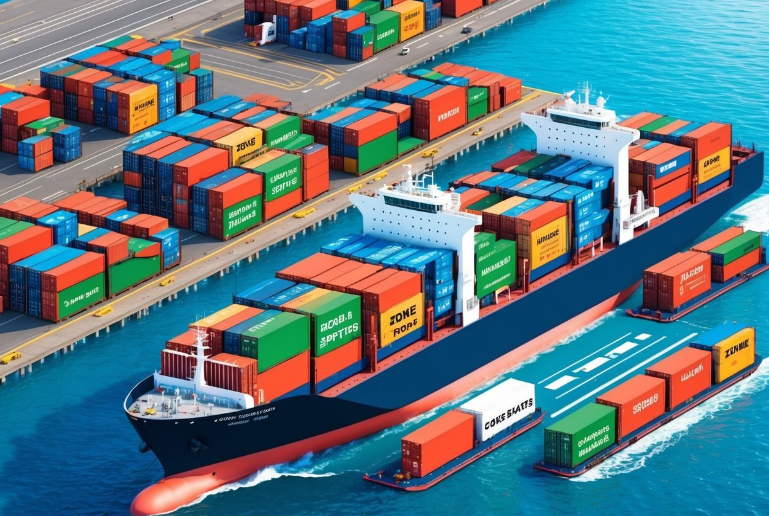
Zone skipping offers multiple advantages that directly impact your bottom line and customer satisfaction levels.
Cost Reduction
The primary benefit is significant cost savings:
- Lower Per-Package Rates: Consolidating shipments gives businesses access to bulk shipping rates that are substantially lower than individual package rates. Savings typically range from 15-40%, depending on volume and distance.
- Reduced Zone Charges: Since packages enter the carrier network closer to their final destination, they cross fewer zones, directly reducing zone-based fees.
- Optimized Fuel Surcharges: Consolidated shipments require less fuel per package compared to individual routing, creating additional savings when fuel surcharges apply.
- Volume Discounts: Consistent large-volume shipments to specific regions can qualify for additional carrier discounts that aren’t available for individual packages.
For a mid-sized e-commerce business shipping consistently, these savings can translate to tens of thousands of dollars annually in reduced shipping costs.
Time Efficiency
Beyond cost savings, time efficiency creates competitive advantages:
- Faster Transit Times: By bypassing intermediate sorting facilities, packages reach customers 1-2 days faster on average. This improvement can transform standard shipping into an experience that rivals premium options.
- More Predictable Delivery: Fewer touchpoints in the shipping process mean fewer opportunities for delays, resulting in more consistent delivery times that businesses can reliably promise to customers.
- Extended Order Cutoff Times: With faster transit times, businesses can offer later daily order cutoffs while still meeting the same delivery timeframes.
These time efficiencies allow businesses to meet rising customer expectations without raising prices.
Risk Mitigation
Zone skipping also helps reduce various logistics risks:
- Fewer Touchpoints: With packages changing hands fewer times between origin and destination, there’s less opportunity for damage, loss, or misrouting. This directly translates to fewer customer service issues and replacement costs.
- Simplified Tracking: Consolidated shipments are easier to monitor until they reach the destination hub, giving businesses better visibility and control over their products in transit.
- Weather and Disruption Buffers: Using multiple regional distribution points creates flexibility during disruptions. If one region experiences delays, businesses can reroute through alternative hubs.
Companies implementing zone skipping report a 30% average reduction in damaged or lost packages, creating additional savings beyond the direct shipping cost reductions.
Is Zone Skipping Right for Your Business?
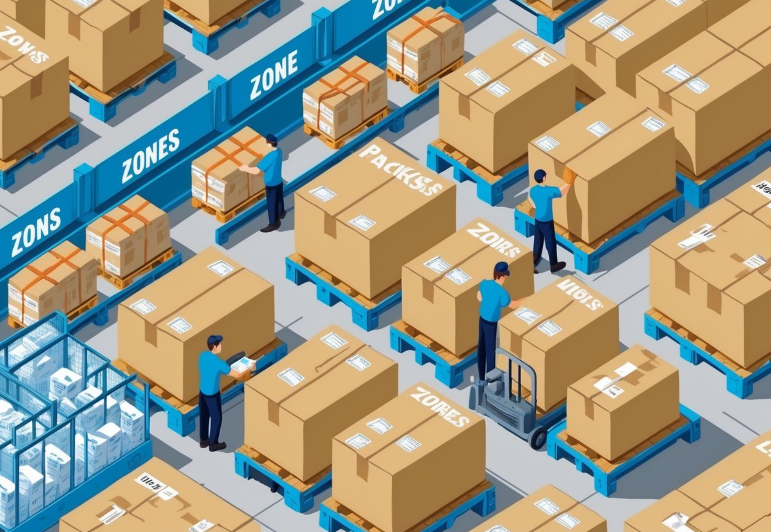
Not every business benefits equally from zone skipping strategies—understanding your shipping profile is crucial to determining its value for your operation.
Assessing Suitability
Consider these factors when evaluating zone skipping for your business:
- Shipping Volume: Zone skipping typically requires meeting minimum volume thresholds to a specific region to be cost-effective. Businesses shipping fewer orders may not realize sufficient savings.
- Geographic Distribution: Analyze your shipping data to identify concentrated delivery areas. This strategy works best when a significant percentage of your shipments go to specific regions rather than being evenly distributed nationwide.
- Product Characteristics: Consider your products’ weight, dimensions, and value. Higher-value items with moderate weight often benefit most from zone skipping due to the balance of shipping costs and protection benefits.
- Delivery Time Requirements: If your business competes on delivery speed, zone skipping can be particularly valuable in meeting customer expectations without premium shipping costs.
A thorough cost-benefit analysis should compare current shipping expenses against projected costs with zone skipping, including any additional handling or transportation requirements.
Implementation Steps
If zone skipping appears viable for your business, follow these steps for implementation:
- Data Analysis: Review 6-12 months of shipping data to identify volume patterns and potential consolidation opportunities. Focus on regions receiving the highest percentage of your shipments.
- Partner Selection: Research and select transportation partners for bulk shipping between your fulfillment center and destination hubs. Consider both cost and reliability in your evaluation.
- Distribution Network: Identify destination hubs in regions where you have significant delivery volume. These could be carrier facilities or third-party logistics providers like Innovative Warehouse Solutions that specialize in regional distribution with a focus on customer service excellence.
- Pilot Program: Start with a single high-volume region to test processes and confirm savings before expanding. This allows you to refine procedures with minimal risk.
- Technology Integration: Ensure your order management and shipping systems can properly route orders for zone skipping. This may require updates to your software integrations.
- Staff Training: Train fulfillment staff on new procedures for consolidating and preparing zone-skipped shipments, which differ from standard package handling.
For companies planning implementation during peak season, reviewing black friday logistics tips can provide valuable insights on managing high-volume consolidation without compromising delivery timelines during the most demanding retail period of the year.
Most businesses can implement a basic zone skipping program within 60-90 days, with ongoing optimization continuing as more data becomes available.
Customer Communication
Effective communication about shipping improvements offers marketing advantages:
- Clear Expectations: Update delivery time estimates on your website to reflect faster shipping times made possible through your improved logistics strategy.
- Shipping Options: Consider creating new shipping tiers that take advantage of these efficiencies, such as “Fast Standard Shipping” that promises delivery times previously only possible with expedited services.
- Marketing Advantage: Promote improved shipping speeds in marketing materials. Customers care about results—faster delivery at reasonable costs—not the logistics methods that make them possible.
- Tracking Updates: Ensure customers receive appropriate tracking information once packages enter the local delivery network from the regional hub.
By communicating these improvements effectively, businesses can turn logistics efficiency into a competitive advantage that builds customer loyalty.
Zone Skipping FAQs
What is zone pricing in logistics?
Zone pricing in logistics is a shipping rate structure based on distance from the origin to the destination. Carriers divide regions into zones, with costs increasing as the delivery zone gets farther from the shipping point.
What does zone mean when shipping?
In shipping, a zone refers to a geographic area used to determine delivery rates. Carriers assign zones based on the distance between the sender and recipient, affecting shipping costs and transit times.
How to calculate shipping zone?
Calculate a shipping zone by measuring the distance between the origin ZIP code and the destination ZIP code. Carriers use predefined zone maps to determine which zone a shipment falls into, influencing pricing and delivery speed.
What are zones in FedEx?
FedEx zones are geographic areas used to calculate shipping costs. Zones range from Zone 1 (local deliveries) to higher zones for long-distance shipments. The greater the zone number, the higher the shipping cost.
What is Zone 1 in logistics?
Zone 1 in logistics refers to the closest delivery area to the shipping origin. It typically covers local or nearby destinations, offering the fastest and most cost-effective shipping rates.
Conclusion
Zone skipping presents a strategic approach to shipping that can significantly reduce costs while improving delivery times. For businesses shipping sufficient volume to specific regions, the benefits extend beyond direct cost savings to include faster deliveries, reduced damage rates, and improved customer satisfaction.
As e-commerce continues to grow and customer expectations for fast, affordable shipping rise, efficient logistics strategies become increasingly important competitive differentiators. Businesses that analyze their shipping patterns and implement targeted zone skipping programs can create both operational efficiencies and marketing advantages.
At Innovative Warehouse Solutions, we prioritize transparent, customer-centric service that stands out in the 3PL industry. Our strategically located facilities and commitment to accuracy make us an ideal partner for implementing zone skipping strategies tailored to your specific business needs.
Ready to explore how zone skipping could benefit your business? Contact Innovative Warehouse Solutions for a consultation on how our fulfillment expertise and software solutions can help you implement cost-saving logistics strategies while providing the real-time, personalized support your business deserves.
Top 7 Order Fulfillment Mistakes and How to Avoid Them
Order fulfillment mistakes can hurt your business. In this article, we cover the top 7 errors businesses make and how to avoid them. By spotting these issues early, you can improve your process and keep customers happy.
The Significance of Efficient Order Fulfillment
Efficient order fulfillment directly impacts business success by ensuring prompt and flawless delivery. Effective order management system helps maintain a stellar reputation and achieve profitability. Streamlined processes enable businesses to meet customer expectations for fast and transparent delivery, significantly influencing overall satisfaction.
For businesses shipping lightweight items directly to consumers, implementing effective small parcel shipping solutions can dramatically reduce delivery times and costs while minimizing handling errors that lead to customer dissatisfaction.
Conversely, poor order fulfillment often leads to damaged items and lost customers, severely affecting business growth. The consequences of inefficient order fulfillment processes are far-reaching, including customer dissatisfaction, increased returns, and negative reviews. Customers today have high expectations for quick and incident-free delivery, and failing to meet these expectations can erode loyalty.
Efficiently locating, packaging, and shipping items in a timely manner remains a significant challenge. Coordinated efforts across various fulfillment aspects are necessary. Prioritizing accuracy and speed ensures customers receive their orders as expected, fostering trust and repeat business.
Order fulfillment isn’t solely about speed; accuracy and reliability throughout the entire fulfillment process are equally important. Each step, from inventory management to shipping, must be optimized to prevent errors and delays. Focusing on these aspects enhances supply chain efficiency and ensures customer satisfaction.
Common Order Fulfillment Mistakes Businesses Make
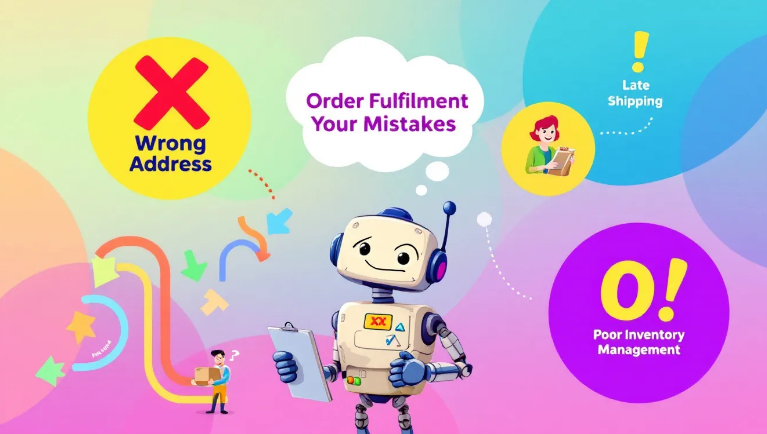
Minimizing common order fulfillment mistakes is vital for online business growth. These errors often arise from inefficient processes, leading to more mistakes and decreased customer satisfaction. As businesses expand, the complexity of order fulfillment increases, making mistakes more likely.
We’ve identified seven common ecommerce fulfillment mistakes that businesses frequently make. Understanding these pitfalls and implementing strategies to avoid them helps streamline fulfillment operations and enhance overall efficiency.
Let’s explore these mistakes in detail.
Poor Inventory Management
Inaccurate inventory management causes stockouts or overstocks, leading to delays and increased fulfillment costs. Effective inventory control is crucial for timely and accurate order fulfillment. Stock distortion can cost businesses $1.1 trillion globally, highlighting the severe financial impact of poor inventory practices.
A robust inventory management system accurately tracks inventory levels and prevents discrepancies. Automated inventory management software provides real-time visibility, crucial for avoiding stockouts and overstocks. Real-time tracking significantly improves inventory accuracy and helps mitigate fulfillment errors.
Inaccuracies in inventory management often stem from manual data entry errors, causing discrepancies in stock levels. Ineffective demand forecasting can result in both overstocking and understocking, leading to inefficiencies. Integrating advanced technology and conducting regular audits are essential for maintaining accurate inventory levels and ensuring efficient order fulfillment.
Packing Errors
Packing errors can lead to damaged products and unhappy customers. Incorrect packing results in costly returns, disappointed customers, and poor reviews.
Ill-fitting packing materials, untrained staff, and careless handling contribute to packing errors. Low-quality packaging can damage products during transit, negatively impacting customer satisfaction. Using high-quality materials and providing proper staff training can mitigate these issues and enhance the packing process.
Shipping Delays
Inefficient order processing significantly contributes to slow shipping, leading to customer dissatisfaction. Slow shipping can result in negative reviews and decreased sales, with 84% of purchasers unlikely to shop with a brand again after a negative delivery experience. Consumers expect quick delivery and may shop elsewhere if delivery is delayed.
Shipping delays often result from inefficient order processing, inventory inaccuracies, and poor warehouse management. Other factors include customer location, carrier choice, and customs requirements. Partnering with reputable carriers and ensuring proper packaging quality can minimize shipping delays.
The right technology and shipping carrier systems, especially during high-volume seasons, enhance shipping efficiency. Optimizing workflows and automating packing can help reduce delays. Integrating with shipping carriers automates label generation, booking shipments, and tracking packages, improving the shipping process and the fulfillment process.
Ineffective Communication with Customers
Poor communication impacts logistics operations, brand image, customer loyalty, cash flow, and overall business goals. Ineffective communication increases customer inquiries and dissatisfaction. If not addressed proactively, customers may feel ignored and frustrated.
Implementing tools like a Knowledge Base and live chat features significantly improves customer communication. Providing clear and timely updates on order status enhances customer satisfaction and reduces inquiries. Effective communication ensures customers feel valued and informed throughout the delivery process.
High Shipping Costs
Determining shipping charges that are both competitive and profitable is often challenging. Ineffective box sizing increases shipping costs and the chances of damage. Over-packing can result in higher material costs, shipping expenses, and environmental waste.
Overlooking shipping costs can erode profits. To mitigate this, businesses should negotiate better shipping rates by leveraging volume discounts and building relationships with shipping partners. Optimizing packaging and shipping strategies reduces costs and improves overall profitability.
Inadequate Returns Management
Inadequate returns management significantly affects customer loyalty, with 85% of online shoppers likely to shop elsewhere after a poor delivery experience. Common challenges include long processing times, unclear return policies, and inefficiencies in restocking, leading to disillusioned clients and increased operational costs.
Confusing return policies and limited options create customer frustration, reducing overall satisfaction with the buying experience. Effective returns management is crucial for sustaining profitability, as highlighted by the high return rates in ecommerce sales.
Implementing clear return policies and efficient restocking processes can enhance customer satisfaction and loyalty.
Scalability Issues
Neglecting scalability in order fulfillment can result in increased inefficiencies and operational errors as a business expands. As businesses grow, inefficiencies and errors can become more pronounced. Investing in scalable systems is critical to maintaining efficiency and accuracy in order fulfillment.
This becomes particularly critical during high-volume seasons, where thanksgiving challenges can overwhelm unprepared fulfillment operations and lead to shipping delays, inventory discrepancies, and damaged customer relationships that persist long after the holiday season ends.
Implementing scalable systems significantly enhances order fulfillment processes and supports business growth. Planning for scalability ensures fulfillment operations remain efficient and effective, even as order volumes increase.
Leveraging Technology for Efficient Order Fulfillment

Leveraging technology in order fulfillment significantly minimizes human errors and improves order accuracy. Automating fulfillment tasks enhances operational efficiency and helps businesses scale effectively. For example, Trans-Matic reduced its receiving time from 3 hours daily to just 20 minutes through enhanced processes.
Many businesses discover that the 3PL advantage extends beyond cost savings to include access to advanced fulfillment technologies and expertise that would be prohibitively expensive to develop in-house, allowing even small companies to offer enterprise-level fulfillment experiences.
Utilizing barcode scanning and RFID technology in warehouses streamlines the order fulfillment process and reduces errors. Real-time visibility into operations, as demonstrated by a leading pharmaceutical manufacturer, improves overall fulfillment efficiency.
Adopting these technological advancements allows businesses to optimize their fulfillment operations and achieve accurate order fulfillment.
Aligning Your Fulfillment Strategy with Business Goals
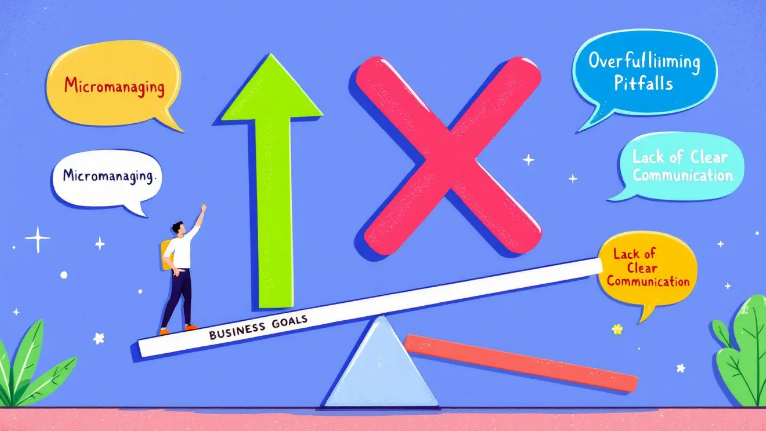
Integrating order fulfillment processes with business objectives enhances supply chain efficiency and meets customer expectations. Collaboration between departments, such as marketing and logistics, is vital for aligning fulfillment strategies with overarching business goals.
Cloud-based warehouse management systems significantly enhance operational efficiency and flexibility. Implementing advanced analytics improves decision-making through insights derived from operational data. A responsive order fulfillment strategy contributes to better customer satisfaction and loyalty by meeting delivery expectations.
Order Fulfillment Mistakes FAQs
What are the 7 steps of order fulfillment?
The 7 steps of order fulfillment are:
- Receiving inventory
- Storing products
- Processing orders
- Picking items
- Packing orders
- Shipping packages
- Handling returns
These steps ensure efficient order processing, timely delivery, and customer satisfaction.
How do you ensure order accuracy?
Ensure order accuracy by using barcode scanning, automated inventory management, and quality control checks. Implement double-check procedures during picking and packing, train staff on accuracy best practices, and integrate real-time tracking to minimize errors.
What is the initial step in the order fulfillment process?
The initial step in the order fulfillment process is receiving inventory. This involves inspecting, counting, and storing products in the warehouse to ensure accurate stock levels and efficient order processing.
What are the three types of order fulfillment?
The three types of order fulfillment are in-house fulfillment, third-party logistics (3PL), and dropshipping. In-house fulfillment means managing orders internally, 3PL involves outsourcing logistics to a provider, and dropshipping allows suppliers to ship directly to customers.
What is a good order fulfillment rate?
A good order fulfillment rate is 95% or higher. This means at least 95% of orders are processed, shipped, and delivered on time without errors. High fulfillment rates improve customer satisfaction and operational efficiency.
How Innovative Warehouse Solutions, LLC Can Help
Innovative Warehouse Solutions, LLC specializes in warehouse layout storage and logistics solutions, securely storing products and distributing them directly to clients. IWS allows users to upload multiple orders at once via a CSV file for simplicity and ease, alongside providing customizable reports for analyzing business performance.
Through strategic warehousing approaches, IWS optimizes inventory placement, picking paths, and storage utilization to minimize handling time and errors, creating more efficient fulfillment operations that scale with your business growth while maintaining accuracy and speed.
Innovative Warehouse Solutions, LLC prioritizes real-time, personalized customer support as part of its customer-centric service. Leveraging cutting-edge technology and industry insights, IWS provides tailored solutions for clients. Partnering with IWS ensures efficient order fulfillment and enhances overall supply chain efficiency.
Omnichannel Fulfillment: A Guide for Modern Retailers
Is your business struggling to connect physical stores, e-commerce, and marketplace sales? Omnichannel fulfillment could be the answer. This integrated approach combines inventory across all sales channels, creating a seamless experience for the customer and simplifying operations for the retailer.
Unlike traditional methods that treat each channel separately, omnichannel breaks down the silos to provide consistent service and visibility – whether the customer shops in-store, online, or through social media.
What is Omnichannel Fulfillment
Modern retail demands flexibility and consistency across all customer touchpoints.
Definition and Scope
Omnichannel fulfillment means the integrated management of inventory, orders, and customer data across all sales channels to create a unified shopping experience. Unlike multichannel fulfillment, which manages each sales channel separately, omnichannel breaks down these silos to create a system.
In a multichannel approach, a retailer might have separate inventories for their online store versus their brick-and-mortar locations. Orders from each channel are processed differently, often with disconnected systems. In omnichannel fulfillment, inventory is treated as a single pool that serves all channels at the same time.
A unified inventory and order management system is the backbone of successful omnichannel fulfillment. This central platform tracks all inventory in real-time regardless of location – whether in warehouses, distribution centers, or retail stores. When a customer places an order through any channel, the system can identify the best fulfillment location based on inventory availability, proximity to the customer, and other business rules.
Why is it Important in Modern Retail
Today’s customer expects convenience and consistency. They might research products on their phone, check availability in a local store, buy online, and pick up in person – all in a single shopping journey. Retailers without integrated systems struggle to meet these expectations and create friction that can drive customers to competitors.
Omnichannel is not just a convenience but a competitive necessity. Research shows that omnichannel customers spend 30% more than single-channel customers. These customers value the flexibility to shop when and how they want, with complete visibility into product availability and fulfillment options.
For retailers, the benefits go beyond customer satisfaction. Integrated inventory management reduces overstock and stockout situations, improves cash flow, and reduces carrying costs. Order routing optimization means faster shipments at lower cost. Data across channels provides valuable insights into customer behavior and preference,s enabling more targeted marketing and product development
Key Differences Between Omnichannel and Multichannel Fulfillment
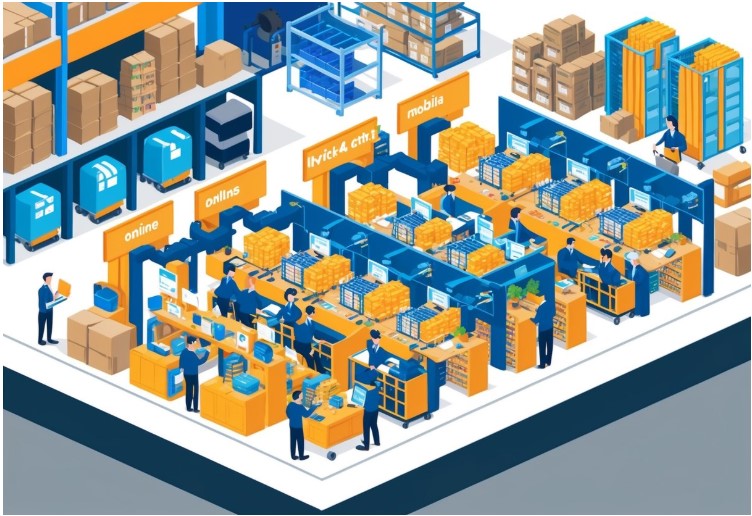
Understanding these differences helps retailers make informed decisions about their fulfillment strategy.
Inventory Management Approaches
In multichannel fulfillment, inventory is typically siloed by channel. A retailer might have separate stock for their website, Amazon storefront, and physical locations. This approach creates several inefficiencies: duplicate inventory, increased storage costs, and the risk of stockouts in one channel while having excess inventory in another.
Omnichannel fulfillment treats all inventory as a single pool. When a customer places an order through any channel, the system can draw from the entire inventory network – whether that’s a distribution center, store backroom, or even another retail location. This approach offers several benefits:
- Reduced total inventory levels while maintaining or improving product availability
- Lower carrying costs and reduced risk of obsolescence
- Ability to leverage all physical locations as mini-fulfillment centers
- More accurate forecasting based on complete sales data
The financial impact can be significant. Retailers implementing omnichannel inventory management typically report 15-30% reduction in overall inventory investment while maintaining or improving service levels. Working with an omnichannel 3PL company like Innovative Warehouse Solutions can help achieve these efficiencies without significant upfront investment.
Customer Experience and Brand Consistency
Perhaps the most visible difference between omnichannel and multichannel approaches is the customer experience. Multichannel retailers often provide disconnected experiences across channels: different pricing, promotions, return policies, and service levels. Customers must navigate these inconsistencies and create friction in the shopping journey.
Omnichannel fulfillment creates a seamless experience where customers can:
- View accurate, real-time inventory availability across all locations
- Start a purchase in one channel and complete it in another
- Choose from multiple fulfillment options (home delivery, in-store pickup, curbside)
- Return items through any channel, regardless of purchase origin
- Access their complete purchase history and preferences across all touchpoints
Brand consistency is another critical element of the omnichannel approach. When customers get the same high-quality experience regardless of channel, it strengthens brand perception and builds loyalty. This consistency extends to packaging, messaging, policies, and service quality.
Benefits of Omnichannel Fulfillment
Implementing an integrated approach yields measurable benefits for retailers of all sizes.
Customer Satisfaction
Today’s shoppers expect options and convenience. Omnichannel fulfillment delivers this by giving customers multiple ways to browse, buy, and receive products. Customers can shop on their terms – whether that’s ordering online for home delivery, buying online for in-store pickup, or shopping in-store with home delivery options.
This flexibility creates a better shopping experience. Customers like having visibility into inventory across all locations, receiving the same service regardless of channel, and seamless transitions between digital and physical shopping experiences. The result is higher customer satisfaction scores, more repeat business, and stronger brand loyalty.
The level of service can also be tailored based on product category and customer segment. For luxury brands or premium product lines within a broader portfolio, incorporating white glove fulfillment services into your omnichannel strategy can create exceptional unboxing experiences and specialized handling for high-value items, further differentiating your brand in competitive markets.
Operational Efficiency and Cost Savings
Beyond customer benefits, omnichannel fulfillment delivers significant operational advantages. By centralizing inventory management and order processing, retailers can:
- Reduce overall inventory levels while maintaining product availability
- Lower warehousing costs through better space utilization
- Minimize shipping costs by fulfilling orders from the most convenient locations
- Decrease labor costs through streamlined picking and packing processes
- Reduce returns handling costs with standardized processes
- Optimize small parcel fulfillment for direct-to-consumer orders, ensuring right-sized packaging and optimal carrier selection regardless of which sales channel generated the order
Technology plays a key role in achieving these efficiencies. Automated order routing can determine the most cost-effective fulfillment location based on inventory availability, shipping distance, and delivery timeframes. Real-time inventory visibility prevents stockouts and overstock situations. Integration between point-of-sale, e-commerce, and warehouse management systems eliminates manual processes and reduces errors.
Working with an omnichannel 3PL services provider can accelerate these benefits without the capital investment required to build omnichannel capabilities in-house. These specialists already have the technology, processes, and expertise to run efficient omnichannel operations.
Sales Growth and Brand Exposure
Omnichannel strategies open up new sales opportunities by meeting customers where they want to shop. Retailers can expand through marketplaces, social commerce and mobile shopping while maintaining brand consistency and fulfillment quality.
This expanded presence typically drives sales growth through:
- Higher conversion rates due to better product availability
- Increased average order value through cross-channel promotions
- More frequent purchases from omnichannel customers
- New customer acquisition through additional digital touchpoints
Unified customer data from omnichannel systems creates marketing opportunities. Retailers get complete customer shopping patterns and can personalize and promote more effectively. Knowing how customers interact across channels helps optimize marketing spend and improve campaign performance.
Challenges of Omnichannel Fulfillment
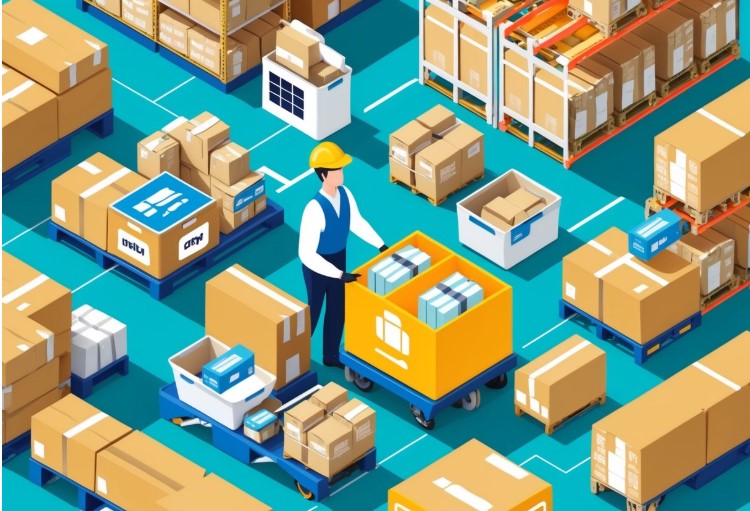
Despite the benefits, it’s not easy to create a true omnichannel operation.
Inventory Visibility and Management
The foundation of omnichannel fulfillment is real-time inventory visibility. Many retailers struggle with this basic requirement because of:
- Disconnected legacy systems that don’t talk to each other
- Manual inventory counting processes prone to errors
- Synchronizing in-store and online inventory
- Tracking inventory in transit between locations
These visibility gaps create customer disappointment when items show as available but are out of stock. They also lead to inefficient inventory allocation, with excess stock in some locations and stockouts in others.
Modern inventory management solutions solve these problems through real-time tracking, automated system synchronizatio,n and predictive analytics to optimize inventory placement. Cloud-based software platforms with robust API connections can bring together disparate systems to give a single view of inventory across all locations and channels.
Technology Integration
Omnichannel fulfillment requires seamless integration between multiple systems:
- E-commerce platforms
- Point-of-sale systems
- Warehouse management software
- Order management systems
- Shipping and carrier management tools
- Marketplace integrations
- Customer relationship management software
Many retailers face integration challenges with legacy systems that weren’t designed for today’s connected commerce world. Custom integrations can be expensive to build and maintain while patchwork solutions create data sync problems and process inefficiencies.
Forward-thinking retailers are addressing these challenges by implementing modern, API-first platforms designed for omnichannel operations. These solutions offer pre-built integrations with common retail systems and flexible architecture that can adapt to changing business needs. Working with technology partners that specialize in retail integration can speed up this transformation.
Supply Chain Coordination
Even with the right technology, coordinating an omnichannel supply chain is a complex operational challenge:
- Determining the best fulfillment location for each order
- Managing split shipments when inventory is distributed
- Coordinating store-based fulfillment without disrupting in-store operations
- Balancing speed, cost, and service levels across fulfillment options
- Managing returns across channels with different processing requirements
- Understanding the distinction between cargo vs shipment to ensure proper documentation and handling protocols across various transportation methods in your logistics network
These require both technology and operational know-how. Automated decision rules can route orders based on business priorities, while exception management processes handle non-standard situations. Staff training across warehouse, store, and customer service teams ensures consistent execution of omnichannel processes.
Creating an Omnichannel Fulfillment Strategy

It’s a process of planning and execution.
Assessing Business Needs
Before implementing an omnichannel strategy, retailers should do a thorough assessment of their current capabilities and customer expectations:
- Audit current systems and identify integration requirements
- Map current fulfillment processes and identify gaps
- Analyze customer shopping patterns and channel preferences
- Benchmark against competitors and industry standards
- Define key performance indicators for omnichannel success
This assessment provides the foundation for a realistic implementation roadmap. It helps identify quick wins that can deliver immediate value while building towards long-term omnichannel capabilities. The assessment should also determine whether to build in-house capabilities or partner with a 3PL.
Customer expectations should guide strategy development. Knowing what drives purchase decisions – whether that’s delivery speed, pickup convenience, or other factors – helps prioritize omnichannel initiatives for maximum impact on customer satisfaction and sales.
Choosing the Right Technology Stack
Technology enables omnichannel fulfillment, so software selection is a key decision. Key components of an omnichannel technology stack are:
- Order Management System (OMS): The central hub that orchestrates orders across channels, determines the best fulfillment location, and provides visibility into order status.
- Inventory Management System: Tracks inventory across all locations in real-time, enables inventory transfers, and supports forecasting.
- Warehouse Management System: Manages picking, packing, and shipping while optimizing warehouse operations.
- Store Fulfillment Tools: Support in-store picking for online orders with mobile apps and process guidance.
- Integration Platform: Connects disparate systems and ensures data synchronization across the technology ecosystem.
When evaluating technology consider both current and future needs. Choose flexible solutions that can scale with business growth and adapt to changing customer expectations. Prioritize vendors with strong integration capabilities and experience in omnichannel retail.
For many retailers, partnering with a 3PL that already has these technology integrations is a faster and more cost-effective way to get to omnichannel. They have already made the technology investments and have the expertise to execute complex omnichannel operations.
Practical Tips for Implementation
The best practices for omnichannel implementation are:1. Start small and scale up. Begin with pilots that test concepts without disrupting the whole business.
- Focus on data. Clean data is key to omnichannel success.
- Train staff. Employees need to know the new processes and the importance of executing them correctly.
- Define metrics. What does success look like and measure consistently.
- Communicate to customers. Set the right expectations during the transition period.
Consider a phased approach that builds capabilities over time:
- Phase 1: Get inventory visibility across all channels
- Phase 2: Enable basic cross-channel fulfillment (e.g., buy online, pick up in-store)
- Phase 3: Add advanced features like ship-from-store and cross-channel returns
- Phase 4: Optimize with analytics and automation
This incremental approach minimizes risk while allowing the business to learn and adapt throughout the implementation.
Omni Channel Fulfilment FAQs
What are the 4 pillars of omnichannel?
The four pillars of omnichannel are customer engagement, seamless integration, data-driven insights, and flexible fulfillment. These pillars ensure a consistent shopping experience across all channels, using data to optimize inventory, logistics, and customer interactions.
What are the 4 C’s of omnichannel?
The 4 C’s of omnichannel are customer, consistency, convenience, and communication. These principles focus on delivering a unified shopping experience, ensuring brand consistency, making purchasing easy, and maintaining clear communication across all platforms.
What is the omnichannel fulfillment model?
The omnichannel fulfillment model integrates multiple sales channels, such as online stores, physical locations, and third-party marketplaces, to optimize inventory distribution and delivery. It allows customers to receive orders via ship-to-home, in-store pickup, or local delivery.
What is omni customer fulfillment?
Omni customer fulfillment refers to meeting customer demands through a unified fulfillment strategy that connects warehouses, stores, and online platforms. It ensures fast, flexible order processing using real-time inventory management and multiple delivery options.
What is an omni fulfillment job description?
An omni fulfillment job involves coordinating inventory, processing online and in-store orders, and ensuring smooth logistics across multiple channels. Responsibilities include warehouse operations, order accuracy, shipping coordination, and improving fulfillment efficiency.
Conclusion
Omnichannel fulfillment has moved from a competitive advantage to a business imperative for modern retailers. Customers now expect seamless shopping experiences across physical and digital channels with consistent service and fulfillment options that meet their individual needs. Businesses that deliver on those expectations build stronger customer relationships, operate more efficiently and position themselves for long-term growth.
Implementing omnichannel fulfillment is complex, particularly around technology integration and operational complexity. Many retailers find partnering with an experienced 3PL is the fastest and most cost effective way to get to omnichannel. They bring the technology, expertise, and scale to execute complex omnichannel operations.
Ready to see how omnichannel fulfillment can transform your business? Contact Innovative Warehouse Solutions today for a personalized consultation. Our logistics experts will help you assess your current capabilities and develop a customized strategy that fits your business goals and customer expectations.
Top Benefits of 3PL Partnerships: A Strategic Business Guide
3PL pros give businesses a competitive edge in today’s market. 3PL providers have become essential partners for companies looking to improve their supply chain and focus on core business activities. As volumes grow and customer expectations rise more companies – particularly in health and beauty, lightweight consumer goods and beverage – are turning to 3PL to stay competitive.
Are logistics holding your business back from growing efficiently? Many companies with revenues over $1M struggle with warehouse costs, shipping inefficiencies and inventory management – all while trying to meet growing customer demands. A 3PL partnership can solve these pain points and more while providing additional benefits that go beyond outsourcing.
This guide explores the key benefits of working with a 3PL and how they can turn your logistics into a competitive advantage.
3PL Benefits
Cost Savings and Efficiency
Lower Overheads: Working with a 3PL reduces overhead costs associated with warehousing and fulfillment. Companies using a 3PL don’t have to invest in facilities, equipment, technology and staff training. Instead of managing multiple warehouses, hiring seasonal staff and maintaining delivery fleets businesses can convert these fixed costs into variable costs based on actual needs.
Economies of Scale: 3PLs serve multiple clients so they can distribute costs across a broader customer base. This allows them to negotiate better rates with carriers and suppliers due to higher volumes. For businesses focused on direct-to-consumer shipping, a 3PL’s efficient small parcel solutions can significantly reduce shipping costs while improving delivery speed, creating a win-win for both businesses and their customers.
Scalability and Flexibility
Handling Fluctuating Demand: One of the biggest 3PL benefits is adaptability during peak seasons and market fluctuations. Professional logistics partners can quickly adjust resources – warehouse space, labour and transportation – to match your current needs. This is invaluable for businesses with seasonal product or unpredictable demand patterns, eliminating the need to have excess capacity all year round.
Ease of Entry: 3PLs provide the infrastructure to enter new markets without major capital investment. Their established networks allow your business to test new regions or scale up operations without committing to permanent facilities. As your business grows a 3PL can handle increasing volumes and expand into new territories with minimal disruption to existing operations. This is especially valuable for e-commerce businesses in health and beauty or consumer goods sectors that are growing rapidly.
Supply Chain Improvement with 3PL
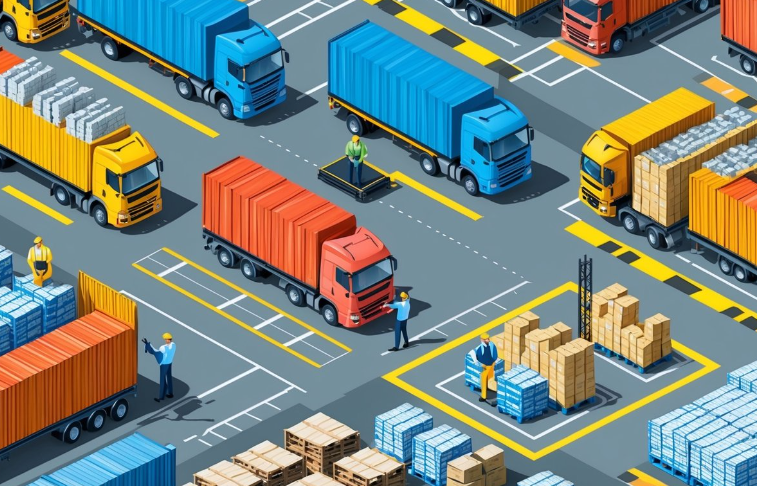
Logistics Know How
Specialist Knowledge: Professional 3PLs bring extensive knowledge that most businesses couldn’t develop internally without significant investment. Their teams understand the complexities of supply chain management, shipping regulations and industry best practices. This expertise helps identify inefficiencies and implement order fulfillment mistakes that could damage your customer relationships, ensuring your operations maintain the highest standards of accuracy and reliability.
Compliance and Risk Management: The complex regulatory environment around shipping and logistics is a challenge, especially for businesses operating across multiple regions. 3PL partners stay up to date with changing regulations, so your operations remain compliant with customs requirements, transportation laws and product specific regulations. They also reduce supply chain risks through contingency planning, alternative routing options and diversified carrier relationships – minimising the likelihood of costly downtime.
Inventory Management
Optimised Storage Solutions: Professional 3PL facilities use advanced warehousing techniques to maximise space utilisation and improve picking efficiency. Modern warehouses use strategic slotting, vertical storage systems and organised inventory zones to reduce handling time and storage costs. These optimisations result in faster order processing and lower labour costs – benefits that would require significant investment for businesses to achieve independently.
Inventory Forecasting: Leading 3PLs use data analytics to help clients predict inventory needs and avoid stockouts and excess inventory situations. With comprehensive product fulfillment expertise, they can analyze historical order data, seasonal trends, and market conditions to provide valuable insights for inventory planning. This proactive approach helps businesses keep optimal stock levels, reducing carrying costs while ensuring product is available when customers order.
Strategic Advantage for Your Business
Focus on Core Competencies
Redirecting Resources: Perhaps the biggest benefit of companies using a 3PL is the ability to focus internal resources on core business functions. By outsourcing logistics operations management teams can devote more time to product development, marketing, sales and customer relationships – areas that directly drive revenue growth. This strategic focus often results in improved performance across main business activities.
Innovation and Growth: When freed from the day to day logistics management businesses can focus more on innovation and strategic planning. The mental bandwidth released from monitoring shipping operations can be redirected towards product development, improving existing products or exploring new markets. This concentration of focus usually accelerates business growth and competitive positioning.
Customer Experience Improvement
Reliable Deliveries: Professional 3PL partnerships deliver higher order accuracy rates than most in-house operations. With established processes and dedicated fulfillment teams 3PLs maintain higher levels of delivery consistency and accuracy. This means when customers get exactly what they ordered when they expect it they’re more likely to come back for more. In today’s competitive market consistent delivery performance is a key differentiator for successful brands.
Responsive Customer Service: Quality 3PLs offer dedicated customer support that strengthens your brand’s service capabilities. When issues arise with shipping customers benefit from fast and knowledgeable support. Innovative Warehouse Solutions stands out by providing real-time, personalized customer support – a big difference from the automated responses of larger providers. This responsiveness helps keep customer relationships intact when shipping problems occur.
Global Reach and Expansion
International Logistics Support: Expanding into new markets presents complex challenges that specialist 3PLs are well equipped to handle. From managing customs documentation to understanding country-specific shipping regulations 3PLs with global experience remove significant barriers to international growth. Their relationships with international carriers and knowledge of import/export requirements simplify cross-border trade, reducing delays and compliance issues.
Market Entry Strategies: When entering new markets businesses can use their 3PL’s existing infrastructure instead of building from scratch. This approach reduces the capital required for expansion and accelerates market entry timelines. A strategic 3PL partner provides valuable insights into regional shipping preferences and helps adapt fulfillment strategies to local expectations, increasing the chances of successful market penetration.
Choosing the Right 3PL Partner
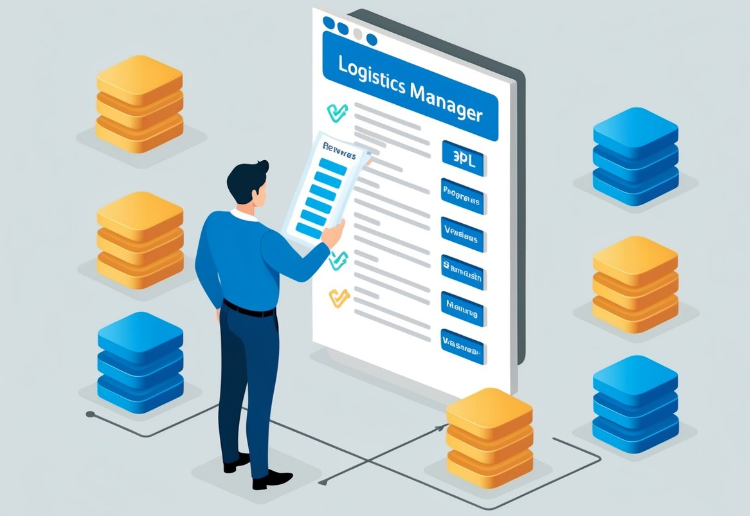
Key Considerations
Industry Experience: The benefits of using a 3PL depend on selecting the right provider for your business. The evaluation process should consider industry experience, especially with businesses of similar size and sector. Following proper 3PL selection criteria is crucial to finding a partner that aligns with your specific business needs and growth objectives. A 3PL with experience in health and beauty or beverage fulfillment will understand the specific handling requirements of these products.
Transparency and Communication: Look for 3PL providers with clear, no-hidden-fees pricing and regular performance reporting. Innovative Warehouse Solutions gives clients access to our management software so you can see in real-time inventory levels, order status and fulfillment metrics – so you’re never out of touch with your business even when we’re managing the physical work.
Building Relationships
Communication: Successful 3PL partnerships rely on open and consistent communication between the two parties. Regular check-ins, dedicated account managers and clear escalation procedures help issues get addressed before they impact customers. The best relationships involve collaborative problem solving, where both business and 3PL work together to improve processes and implement new solutions.
Metrics: Agree clear, measurable performance standards from the start of the relationship. Typical metrics include order accuracy, on-time delivery rates, inventory accuracy and return processing time. Regular reviews against these metrics maintain accountability and identify areas for improvement. As the relationship evolves, these metrics should adapt to changing business priorities and market conditions.
3PLs Pros FAQs
What are the advantages and disadvantages of 3PL?
The advantages of 3PL include cost savings, scalability, and improved logistics efficiency. Businesses benefit from expertise, technology, and access to a global network. However, disadvantages include loss of control, potential service issues, and dependency on external providers, which may impact flexibility and customer experience.
How does a 3PL make money?
A 3PL makes money by charging fees for warehousing, order fulfillment, transportation management, and value-added services. Revenue streams include storage fees, pick-and-pack charges, shipping markups, and contract-based logistics solutions. Some 3PLs also profit from bulk shipping discounts negotiated with carriers.
What services do 3PLs generally provide?
3PLs generally provide warehousing, inventory management, order fulfillment, transportation coordination, and returns processing. Additional services may include freight forwarding, customs brokerage, and value-added services like kitting and packaging. These solutions help businesses streamline supply chain operations.
What are the risks involved in using 3PL?
The risks of using a 3PL include loss of control over logistics, potential service disruptions, data security concerns, and reliance on a third-party provider. Poor performance by the 3PL can impact delivery times, customer satisfaction, and brand reputation.
What is the future of third-party logistics?
The future of third-party logistics includes increased automation, AI-driven analytics, and sustainable supply chain solutions. Growth in e-commerce and global trade will drive demand for faster, more efficient fulfillment. 3PLs will adopt robotics, real-time tracking, and green logistics to enhance efficiency and reduce costs.
Conclusion
The benefits of 3PL partnerships go far beyond cost savings. By working with specialist logistics providers businesses can turn their supply chain into a competitive advantage. From operational efficiency to better customer experience the 3PL advantage touches nearly every area of modern business.
When considering a 3PL partnership remember finding the right provider is key to realising these benefits. Take time to evaluate potential providers based on your business needs, growth plans and company values. With the right 3PL relationship you can focus on your core competencies and deliver exceptional logistics performance customers expect.
Ready to experience these benefits for yourself? Contact Innovative Warehouse Solutions to discuss how our customer focused 3PL services can support your growth ambitions and remove logistics headaches.
Product Fulfillment: From Order to Delivery
Product fulfillment is the backbone of any e-commerce business. The process turns a customer’s online purchase into a package at their doorstep. For growing brands, mastering product fulfillment isn’t just helpful – it’s essential for long-term success.
Are operational headaches stopping you from focusing on growing your business? Many companies get bogged down by complex logistics instead of creating new opportunities for sales. This guide breaks down the six steps in the order fulfillment process and provides tips to improve your operations, reduce costs, and increase customer satisfaction.
What is Product Fulfillment?
Definition and Scope
Product fulfillment covers the entire process from when a customer places an order until they receive their package – and sometimes beyond. This includes receiving inventory, storing products, processing orders, picking and packing items, shipping, and handling returns.
For businesses primarily shipping individual packages directly to consumers, implementing efficient small parcel fulfillment solutions becomes an essential part of your fulfillment strategy to minimize costs while maximizing delivery speed and reliability.
The Six Steps of the Order Fulfillment Process
The order fulfillment process consists of six key steps that work together to create a smooth operational flow:
- Receiving Inventory: This first step involves accepting shipments from manufacturers or suppliers, inspecting products for quality, and logging them into your inventory system.
- Storing Inventory: Products need to be organized and stored efficiently based on size, demand, and other factors to minimize picking time later.
- Processing Orders: When a customer places an order, your system needs to verify payment, check inventory availability, and create picking lists for warehouse staff.
- Picking and Packing: Warehouse staff locate the ordered items (picking) and prepare them for shipment with appropriate packaging materials and order documentation (packing).
- Shipping: Packed orders are labeled with shipping info, carriers are selected based on cost and delivery timeframes, and packages are sent to customers. Effective parcel management at this stage ensures optimal carrier selection, cost control, and delivery timeframes.
- Returns Processing: A well-structured returns process handles products coming back from customers, including inspections, restocking, exchanges, or refunds.
Each step must work together to get customers their orders correctly and on time.
Key Parts of a Fulfillment Strategy
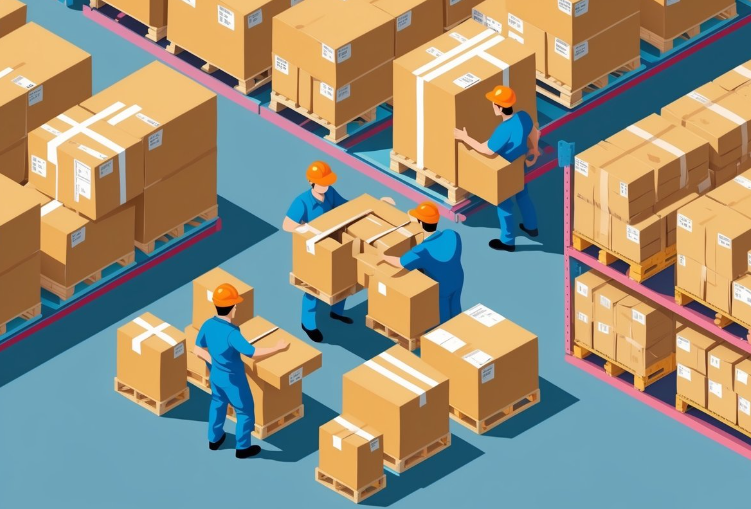
Inventory Management
Inventory management is the foundation of product fulfillment. Without real-time visibility into your inventory levels, your whole operation will break at the first step.
A robust inventory tracking system allows you to monitor stock levels continuously, predict when to reorder products, and maintain optimal inventory levels. This prevents two common and costly inventory problems:
- Overstocking: Tying up capital in excess inventory that sits on shelves
- Stockouts: Disappointing customers with “out of stock” messages that may send them to competitors
Modern inventory management systems integrate with your sales channels to automatically update inventory counts as orders come in. This gives you accurate data to make informed purchasing decisions and keep the balance between having enough stock without overcommitting resources.
At Innovative Warehouse Solutions, we provide clients with real-time inventory tracking and detailed reporting so you can focus on product development and marketing while we handle the complexity of inventory management.
Fast Order Processing
Order processing speed and accuracy impact customer satisfaction. Today’s customers expect quick fulfillment – often within days of ordering.
Streamlining your order workflow involves the following:
- Automating order capture from multiple sales channels
- Prioritizing orders based on shipping method or other criteria
- Batching similar orders to improve picking efficiency
- Implementing quality control checkpoints to catch errors before shipping
Order processing software eliminates manual data entry, reduces errors and speeds up the process. The right system can integrate with your e-commerce platform, shipping carriers and accounting software to create a seamless flow of information across your business operations.
Small to medium-sized brands often find that partnering with a 3PL provider like IWS gives them access to advanced order processing systems without significant technology investment.
Advanced Fulfillment Strategies
Technology and Software
Modern fulfillment operations rely on specialized software systems to stay efficient. Two key technology components are:
Order Management Systems (OMS) centralize order information from all sales channels, providing a single interface to process orders regardless of where they came from. These systems handle everything from initial order capture to delivery confirmation.
Warehouse Management Systems (WMS) focus on optimizing physical operations within your fulfillment center. They direct warehouse staff on efficient picking routes, manage inventory locations, and provide data on operational performance.
The connection between these systems and your existing business platforms creates a coordinated ecosystem that shares data in real time. This automation reduces manual work, minimizes errors, and speeds up the fulfillment process.
Our software solutions at Innovative Warehouse Solutions integrate with popular e-commerce platforms, so you get enterprise-level technology without the hassle of managing it yourself.
Fulfillment Operations
The physical layout and operational procedures within a fulfillment center can have a big impact on efficiency. Strategic planning considers:
- Product placement: Storing high-volume products near packing stations
- Zone organization: Grouping similar products for easier location
- Workflow design: Creating traffic patterns to improve picking speed
- Space utilization: Maximizing storage while maintaining accessibility
Understanding what are the benefits of companies using a 3PL can help determine if outsourcing is right for your business. With advantages like reduced capital investment, access to specialized expertise, and flexible scaling capabilities, many growing brands find that 3PL partnerships offer a smoother path to expansion than building in-house operations.
Customer Experience through Fulfillment
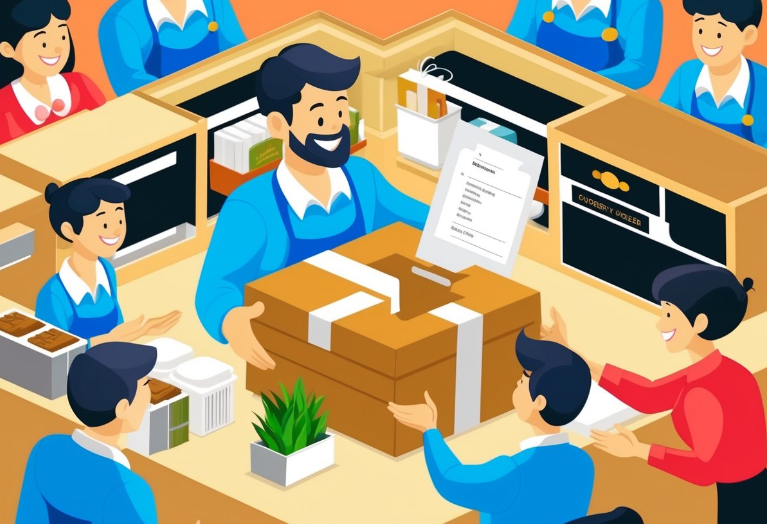
Transparency and Communication
In today’s connected world, customers expect visibility of their orders from purchase to delivery. Providing tracking information and updates builds trust and reduces customer service inquiries.
Clear policies on delivery timeframes, international shipping, and potential delays help manage customer expectations from the start. When delays occur (weather, supply chain issues, or other factors), proactive communication makes a big difference in customer satisfaction.
Our commitment to transparent and responsive customer service sets us apart in the 3PL industry. We provide real-time updates and personalized support to help you maintain strong customer relationships.
Returns Management
An efficient returns process is a customer service function and a feedback mechanism. Making returns simple increases customer confidence when making purchase decisions.
A well-designed returns process should:
- Provide clear instructions and simple return methods
- Process refunds or exchanges quickly
- Inspect returned items quickly to determine if they can be restocked
- Track return reasons to identify product issues
Returns data provides insight into product quality, product description, and customer preferences. Analyzing this data helps improve product offerings and reduce future returns.
Personalized Customer Experience
Fulfillment is an opportunity to create brand impressions. Custom packaging, thank you notes, or small gift additions can turn standard delivery into something special that customers remember and share.
Even small things like branded packaging tape or custom boxes increase brand recognition and create a cohesive experience from online shopping to delivery.
These custom touches can be hard to implement at scale for businesses looking to grow. Our team at Innovative Warehouse Solutions can help you create and execute custom packaging solutions that match your brand identity while maintaining operational efficiency.
Product Fulfillment FAQs
What is the difference between fulfillment and delivery?
The main difference between fulfillment and delivery is that fulfillment involves receiving, processing, and packaging orders, while delivery refers to the final step of transporting the package to the customer. Fulfillment includes inventory management, order picking, and packing, whereas delivery ensures the package reaches its destination.
What are the disadvantages of in-house fulfillment?
The disadvantages of in-house fulfillment include high operational costs, resource limitations, and scalability challenges. Businesses must invest in warehousing, staffing, and technology. Inefficiencies in inventory management and shipping can lead to delays, errors, and increased expenses compared to outsourced fulfillment solutions.
What are fulfillment services?
Fulfillment services handle the storage, picking, packing, and shipping of business orders. Third-party logistics (3PL) providers manage these tasks to streamline order fulfillment, reduce shipping times, and improve efficiency. These services benefit e-commerce companies by reducing costs and improving customer satisfaction.
What is perfect order fulfillment?
Perfect order fulfillment means delivering the right product, in the correct quantity, to the right customer on time, and without damage. It requires accurate inventory management, efficient picking and packing, and reliable shipping to minimize errors and ensure customer satisfaction.
What are the duties of order fulfillment?
The duties of order fulfillment include inventory management, order processing, picking and packing, shipping coordination, and returns handling. These tasks ensure accurate and timely delivery, improving efficiency and customer satisfaction. Businesses rely on streamlined fulfillment processes to reduce costs and enhance logistics.
Bottom Line
Fulfillment connects your online presence to customer satisfaction. Every step in the process offers opportunities to improve, save, and enhance the customer experience.
As customer needs and expectations change, businesses need to refine their fulfillment strategies regularly. Those who view fulfillment as a competitive advantage win.
By working with the right 3PL provider, you can have a fulfillment operation that delivers products on time, strengthens your brand, and supports your growth goals. Contact us to learn more about how Innovative Warehouse Solutions helps businesses like yours focus on growth while we handle the complexity of order fulfillment.
Smart Parcel Management: Key Strategies for E-commerce Success
Parcel management is at the heart of e-commerce, and it is how products move from warehouse shelves to customers’ doorsteps. For businesses in health and beauty, lightweight consumer goods, and beverage shipping 300+ orders a month, implementing parcel management solutions directly impacts bottom-line results and customer satisfaction.
Today’s market demands more than just shipping – it requires intelligent systems that reduce costs, improve delivery reliability, and provide the seamless experience customers expect.
What is Parcel Management?
Parcel management encompasses the whole package handling process, from processing orders and selecting carriers to tracking shipments and managing returns. This systematic approach is crucial for e-commerce businesses that need to control outbound shipments while controlling costs and meeting customer expectations.
For businesses seeking growth, implementing efficient small parcel shipping solutions becomes essential as order volumes increase beyond what manual processes can efficiently handle. When done right, parcel management reduces shipping costs, minimizes errors, speeds up delivery times, and creates the reliability that builds customer loyalty – precisely what Innovative Warehouse Solutions delivers through our transparent, customer-focused approach.
How to Implement Effective Parcel Management Solutions
Successful parcel management requires several interconnected components:
Parcel Tracking Technologies
Modern tracking systems provide unparalleled visibility into the shipping process for both businesses and customers. These systems provide automated updates at key touchpoints throughout delivery, reducing customer service queries and increasing satisfaction.
Real-time tracking allows businesses to monitor shipments from warehouse to doorstep, with alerts for delays or exceptions that require intervention. For customers, tracking notifications via email or SMS creates transparency and builds trust – especially important for high-value products in health and beauty or time-sensitive beverage deliveries.
Address Validation and Delivery Route Optimisation
Address validation is the foundation of delivery reliability. Businesses can automatically check addresses against carrier databases to identify and correct errors before packages ship. A simple step that prevents failed deliveries and returns and addresses correction fees that eat into profit margins.
Delivery route optimization uses algorithms to find the most cost-effective shipping routes. These systems analyze multiple factors – package dimensions, weight, destination, delivery deadline, and carrier rates – to select the best shipping option.
Integration with Existing Systems
The true power of parcel management comes from integration with existing business systems. When connected to e-commerce platforms, inventory management software, and customer relationship management (CRM) tools, parcel management creates a unified data ecosystem that eliminates information silos.
Integration with Enterprise Resource Planning (ERP) and Warehouse Management Systems (WMS) allows for:
- Automatic order processing with minimal manual intervention
- Consistent data flow across all business operations
- Reduced double entry and associated errors
- Improved coordination between your shipping department and other operational teams
- Better business insights
IWS software specialize in creating these seamless integrations so businesses can connect parcel management with existing operational tools.
Advanced Parcel Management Systems
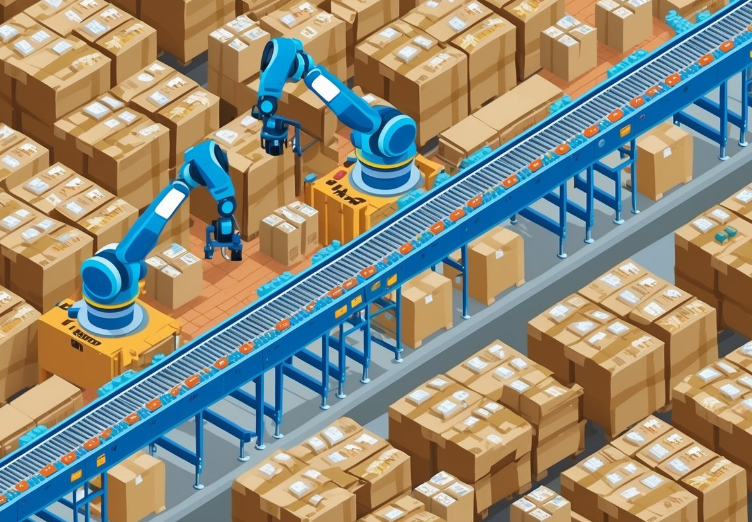
Benefits and Features
Advanced parcel management systems deliver tangible benefits that impact the bottom line:
Cost reduction through carrier rate comparison, dimensional weight optimization, and consolidation opportunities. These systems compare rates across multiple carriers and service levels and find the most cost-effective option for each shipment.
Improved customer service through better delivery accuracy and communication. Advanced systems provide customers with proactive delivery updates, expected arrival times, and self-service tracking options that reduce support queries and improve satisfaction. They are key differentiators for IWS in an industry known for poor service.
Key features of modern parcel management systems include:
- Automated rate shopping across multiple carriers
- Batch processing for high-volume shipping
- Parcel consolidation to combine multiple orders
- Exception management for proactive issue resolution
- Detailed analytics and reporting for continuous improvement
Choosing the Right Software
When choosing the right parcel management software, businesses need to evaluate it against their needs. Key criteria include:
Scalability: the system can grow with your business, handling increased volume without performance degradation. The best solutions adapt to seasonal fluctuations (especially during winter peaks) without requiring a complete system change.
User experience determines how quickly staff can learn and use the system. Simple interfaces reduce training time and user errors and improve adoption rates. Look for systems with transparent workflows, good documentation, and responsive support.
Additional considerations include integration, mobile access, customization options, and total cost of ownership. The right solution balances current needs with future requirements and is within budget.
Building a Parcel Management Strategy
Data Driven
Parcel management strategies start with data analysis that reveals operational patterns and opportunities. By looking at historical shipping data, businesses can see carrier performance, seasonal volume fluctuations, and cost variations across different shipping methods.
This is the foundation for data-driven decision-making that optimizes parcel management. Businesses can better resource, anticipate busy periods, and make informed career choices based on actual performance metrics, not assumptions.
Setting clear Key Performance Indicators (KPIs) objectively measures parcel management success. Core metrics include:
- Average cost per order
- On-time delivery percentage
- Order accuracy rate
- Return processing time
- Customer satisfaction with delivery experience
Monitoring these KPIs helps identify improvement areas and measure changes’ impact over time.
Working with Fulfillment Providers
Partnering with fulfillment providers is an alternative to parcel management that can benefit growing businesses. Third-party logistics (3PL) companies like Innovative Warehouse Solutions provide expertise and infrastructure that would be expensive to develop in-house.
These partnerships offer:
- Access to negotiated carrier rates through volume aggregation
- Reduced capital investment in warehouse space and technology
- Flexible capacity to handle peak periods
- Geographic distribution for faster local delivery
- Specialized product fulfillment services tailored to your specific industry requirements
Outsourcing parcel management allows businesses to focus on product development, marketing, and growth while the experts handle the operational burden – which is exactly what IWS does.
Future of Parcel Management

Technology
Parcel management is evolving with new technologies. Artificial intelligence and machine learning algorithms are now providing predictive analytics that forecast shipping disruptions, optimize inventory placement, and recommend the best carrier for a specific route.
Automation is advancing parcel management through:
- Robotic picking and packing systems
- Autonomous vehicles for last-mile delivery
- Drone delivery for rural or hard-to-reach areas
- Smart lockers and alternative delivery points
These technologies will reduce costs and improve speed and delivery in the delivery process. For smaller businesses competing with global players like ShipMonk, adopting these technologies through partnerships with forward-thinking 3PLs like IWS is a cost-effective way to stay competitive.
Sustainability
Environmental considerations increasingly influence parcel management decisions as consumers vote with their wallets. Savvy businesses are adopting eco-friendly practices such as:
- Right-sized packaging to reduce waste and dimensional weight
- Recyclable and biodegradable packaging materials
- Carbon-neutral shipping options
- Route optimization to reduce fuel consumption
- Consolidated deliveries to reduce transportation impact
These green initiatives reduce environmental impact and appeal to environmentally conscious customers who want to support sustainable businesses.
Parcel Management FAQs
What is a parcel management system?
A parcel management system automates the receiving, tracking, and delivery of packages. It integrates barcode scanning, notifications, and reporting to streamline logistics. Businesses use it to enhance efficiency, reduce lost parcels, and improve customer satisfaction.
What is parcel spend management?
Parcel spend management optimizes shipping costs by analyzing carrier rates, negotiating contracts, and tracking expenses. It helps businesses reduce costs, improve efficiency, and ensure carrier compliance through data-driven insights.
How does the parcel tracking system work?
A parcel tracking system uses barcode scanning, GPS, and real-time updates to monitor shipments. Each package receives a tracking number scanned at various checkpoints to provide location updates. Customers and businesses use tracking systems for visibility and delivery accuracy.
Summary
Smart parcel management has moved from a back-office logistics function to a competitive advantage in e-commerce. Businesses implementing a parcel management solution achieve operational efficiency, cost savings, and a better customer experience that drives growth and profit.
As commerce moves online, the ability to manage parcels throughout their lifecycle becomes more and more critical to business success. Companies that invest in parcel management systems and strategies are best placed to meet customer expectations, control costs and adapt to changing market demands.
For businesses in health and beauty, lightweight consumer goods, and beverages growing in size, partnering with specialized fulfillment providers like Innovative Warehouse Solutions is a way to get professional parcel management without significant infrastructure investment. So they can create more orders and let IWS handle the operational details.

